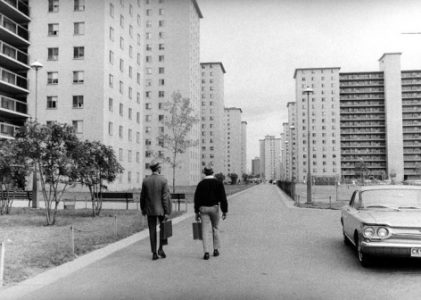Origin of the problem
The economy slides
During the Great Depression years of the 1930s decade, our nation was in a severe economic crisis that caused a complete slide in the harmony of the U.S. economy. The 1920s were a time of great economic success in this country that offered several sources of employment for many families but once the stock market crash on October 29, 1929 happened this country would go through a living hell for over a decade. By the year 1930, 25% of Americans were left jobless while another large percentage of those that kept their jobs were forced to take major pay cuts or be reduced to part time status. The problem with being unemployed in the early 1930s was the fact that there were no unemployment benefits or any sort of protection for the many millions of Americans suddenly out of work. There was also no public aid to feed the many destitute people that were lining up at soup kitchens nearly fighting each other over a bite to eat. Men that had been employed their whole lives and had wives and raised children now found themselves living in the slums or in “Hoovervilles.” Hoovervilles were shantytowns built by men that had lost everything, their job, and their homes and sometimes their families, so they resorted to building their own houses that had no plumbing, no floors, no electricity, they were just shacks built out of stone or wood and simply served as a place to sleep in. They named them “Hoovervilles” because they blamed President Herbert Hoover for allowing the economy to collapse which left then in these shantytowns.
The other option for those that became severely underemployed was to take up residence in the many run down slum houses around the city that were very old and poorly constructed houses and apartment buildings that did not have running water, plumbing and often times had no floors. These buildings were heavily deteriorated, vermin infested, unsafe sights of extreme desperation in communities that had seemingly lost all hope. The worst slums in Chicago were in Little Sicily (in the Near North Side neighborhood), Back Of The Yards, Near West Side and along the black belt which was a row dilapidated slum houses from Cermak Road down to 71st Street mostly along State Street but was now expanding further east. There were also really tough slums in the southern part of the Loop neighborhood and also in the South Loop section of the Near South Side that had several dilapidated apartments. These run down areas were slums and used by the poor since the 19th century but now thanks to the Great Depression these slums were being filled up even more and now greedy slum lords could profit from all this by charging higher rent than what the dwelling was worth, and desperate families could not say no because there was nowhere else to go. Besides these slums being an unattractive eye sore for such an elegant city, they were also highly unsafe and many people in these communities lived among disease and unsafe conditions, infant mortality rates were alarmingly higher than in the rest of the city.
Earliest African American settlement
African Americans have been living in Chicago since 1833; the first neighborhood blacks took residence in was the Near West Side in the North West quadrant of the neighborhood that we call the United Center Park neighborhood in later years. After the Civil War, African Americans began taking up residence in the South Loop within Chicago’s Near South Side neighborhood as that area was becoming older and less desirable by white upper classes, and the old elegant apartments were divided into kitchenette style apartments which often needed to house more than one family in each apartment.
The South Loop was also badly fire damaged by the Great Chicago Fire of 1871 and instead of renovating the area; it was left to impoverished blacks and other poorer groups of people. Both black communities had one thing in common, they were both run down and brought about harsh living conditions where blacks had to live among the criminal underworld such was the case in the South Loop that became home to the notorious Levee District that was full of prostitution, illegal gambling and even several violent crimes.
There was nowhere else to go in the city because restrictive racial covenants were in full force all around the city as they were approved by the U.S. courts to be enforced which laid out in writing that property owners were not allowed to rent or sell property to blacks in certain neighborhoods and that basically meant well over 90% of the city was segregated off to black families, this pushed them into the slum of the South Loop and the Near West Side.
In the 1890s African Americans went into a hard fought battle to move into the Grand Boulevard neighborhood and the Douglas neighborhood as black migration increased between 1870 and 1890 which now brought the black population from 1,000 to over 15,000 by 1890 and now the South Loop and Near West sections were not large enough to support the black population; therefore, opportunity was needed in these two aging communities that also provided ample employment for unskilled labor for the many black southerners that were coming in.
During the times of slavery and the years preceding slavery in the south, African Americans were deprived of education and entry into good paying positions of employment. Education and other skilled labor training is vital in order for anyone to achieve a skilled labor position which is still prevalent today, in the southern states blacks were forbidden from achieving the schooling and skilled labor training to achieve higher wages and Chicago did not offer much of that training to blacks either; however, there was much better and more plentiful unskilled labor positions available for a black family to make a living and afford a place to live even though it was not a desirable dwelling.
During World War I African American migration from the southern states to Chicago heavily increased because there was a massive shortage in the manufacturing labor force due to white men being drafted or enlisting to participate in the war effort which even freed up some higher paying jobs for some blacks. Chicago was the Promised Land for impoverished black southerners that answered the call of the Chicago Defender newspaper that let the black community in the south know it was an opportunity of a life time, but the opportunity may have brought employment but it also brought the newly arrived blacks into the slums of the black belt that now extended from Cermak Road to 63rd Street all along State Street.
Even though the manufacturing companies sorely needed blacks to fill the many open positions, the vast majority of the white community in the city did not want blacks in their neighborhoods or using any of their facilities, there were constant conflicts between blacks and whites when blacks tried to use facilities, gain employment in retail and restaurant in the Loop, or use public areas such as beaches. A massive conflict over beach use happened in the Douglas neighborhood in the year 1919 when a black child accidentally swam onto the “white side” of the beach and was drowned by a group of white youths, this started a massive race war between blacks and whites that cost lives and destroyed buildings and homes.
By the 1920s African Americans became the vast majority in the southern part of the Near South Side, Grand Boulevard, Douglas and Washington Park communities along with having some settlement in Englewood, West Englewood, Woodlawn and the original Near West Side settlement; however, every other neighborhood in the city had less than a 1% African American population.
Grand Boulevard and Douglas became the most successful of all the black neighborhoods as it was swimming with jazz clubs, restaurants and several more black owned businesses. The many middle class and upper class blacks stimulated the local economy and were even the business proprietors of the many establishments that served the black community and the many jazz clubs and soul food restaurants were even appealing to visiting white Chicagoans. These communities even had their own lending institutions and banks to directly serve the black community which kept investment strong in Bronzeville until the stock market crash of 1929 that put our nation into the Great Depression era.
The black community was the most devastated by the economic downturn as several black owned businesses closed down and black owned lending institutions and banks saw their ending days. Massive cuts of unskilled labor positions first targeted African American workers due to racially discriminatory employment practices that were fully legal in the 1930s. It did not matter if a black employee was a harder worker than his white co-worker when it came time to cut jobs; it was the black employee that was laid off first. More than half of the blacks of the black community had become jobless or severely underemployed which brought many African Americans to take up employment with the Policy racket that extended employment to over 10,000 black residents in Bronzeville, even though it was illegal employment it put food on the table and it also revived a lot of the lost economy in Bronzeville.
The New Deal
In 1933, there seemed to be no end in sight with this economic recession that quickly turned into a full depression in the early half of 1933, this is when our new president Franklin D. Roosevelt enacted the “New Deal” which was a plan to improve on several aspects of the economy. This New Deal brought protection for banks and lending institutions because when the banks fell apart during the depression so did any financial help for businesses that were economically strained from the Depression, which caused a domino effect as banks fell so did the businesses that relied on them then the workers of those businesses were effected as they could no longer bring home wages to support the retail economy which would cause more businesses to close. Regular citizens suffered sudden drains on their bank accounts, because back then your money was not secure like it is now, and all your savings could go up in smoke if the bank failed.
The New Deal also offered unemployment insurance with the Social Security Act of 1935 so families had a small source of income to pay rent and buy food, this could also keep families out of Hoovervilles. The New Deal also helped provide welfare to those that were disabled or too elderly to work, this was important in these days because many of the factories were unsafe and workers would often receive crippling injuries that prevented them from holding down employment. Another social problem the New Deal planned to attack was to rid the cities of slums and put the impoverished in better and humane housing which was sorely needed in Chicago especially in the black belt, Near West Side and the Near North Sides’ “Little Hell” community. The need to bring about better housing for poor Americans brought about the National Housing Act Of 1934 which geared toward making mortgages more affordable and to stop bank foreclosures on homes, then in 1937 the New Deal brought about the United States Housing Authority that was a new government administration geared toward providing affordable housing and clearing out slums, in Chicago the entity was known as the Chicago Housing Authority.
The Chicago Housing Authority gets to work
As soon as this new CHA administration was formed they knew they had to get to work immediately in order to deal with the various Chicago slums. The first project buildings that was to go up were the Julia C. Lathrop Homes to be built in the North Center and partially in the Lincoln Park neighborhoods. The immediate goal was to house impoverished white Chicagoans, especially the Italians and Irish that resided in the slums of Little Hell/Little Sicily.
Working with the Public Works Administration, the CHA was able to open up the first housing project in the city; however, this complex was off limits to people of color due to the fact that North Center and Lincoln Park were not friendly to minorities and also because the city had a higher priority on housing poor whites for the first public housing project. Housing projects tenant racial makeup was supposed to reflect the racial makeup of the community in the 1930s and 1940s. Elizabeth Wood was the first director of CHA and from the start she wanted to provide fair housing opportunities for all poor Chicagoans regardless of race but there were certain rules that had to be followed and that meant no blacks or any others were allowed in the Lathrop projects, in fact, there was not much room for minorities in the three new complexes CHA was planning to build in 1938.
The South Deering neighborhood was an ideal spot for another housing project, it was an all-white neighborhood and there was several acres of vacant land, and also it was right in the heart of the steel industry that employed both skilled laborers and unskilled laborers, perfect for public housing in an area where the impoverished family could get back on their feet by taking up a position in the steel industry then eventually make their way out of public housing. The South Deering community was a completely white community with a small Mexican population but there were no blacks in this neighborhood nor did the neighborhood want blacks living in the community, so these projects were only for white families and residents in the projects aimed to keep it that way.
Another 1938 project was to be built in a neighborhood that had a long history of having impoverished Chicagoans, the Near West Side which was the home of the “Jewish Ghetto” in the southern part of the neighborhood. The neighborhood for the projects placement was the site of “Little Italy” that was a poorer Italian neighborhood. The new public housing project, the Jane Addams Homes was constructed right in the heart of Little Italy and right next to the Jewish Ghetto. These areas of the Near West Side did not allow blacks or Mexicans from the northern part of the neighborhood in their area so the projects naturally had to follow the restrictive racial covenants of these streets. Once again African Americans from the struggling Near West Side ghetto and the black belt on the south side were denied public housing except for a small 2.5% of the Jane Addams Homes got filled by black families only because no more white families were waiting in line to get in and the vacancies needed to be filled. These projects mainly were for impoverished Jewish and Italian families.
The first black project
When public housing was first built it was great news to the impoverished and hardworking family that was forced to live a life in the dilapidated slums. These families went to work every day and worked their fingers to the bone yet the wages they got in exchange for their hard work were almost insulting, but that is the price paid when one is classified as an unskilled worker. Even lower level skilled workers had a tough time putting food on the table when they had very large families of four or more children.
A skilled worker that was valuable in the 1920s that made good wages, owned a home and decided to build a large family would suddenly be devastated once the dark cloud of the Great Depression came to steal away the comfortable livelihoods of many Americans that took their homes and well being, because of the lack of unemployment benefits that were not offered until 1935, caused many Americans to be unable to pay their mortgages in the earlier 1930s and the banks took their prized homes. This type of situation crushed even the skilled worker that had a decent job but still needed to support a large family while dealing with a pay cut, the best housing option then was to live in the slums in an old deteriorated house or in an old dilapidated apartment in a one room kitchenette apartment, this was the story of many Americans of all races during the 1930s but it was especially prevalent within the black community because wage cuts and layoffs were first served to black Americans and this is what devastated Bronzeville.
Even a skilled African American worker that graduated high school or graduated college or trade school or maybe received skilled training would end up in the slums during this era. There were also scores of underemployed working class black families living in these same slums along State Street dreaming about having the simple things in life like running water and a toilet that many Americans were finding to be standard household features by the 1930s but in the black belt, Back Of The Yards and Little Hell these were luxuries.
The Chicago Housing Authority had now catered to the needs of those in the white ghettos now there needed to be help for the black ghetto and this is when the construction began on the Ida B. Wells housing project in the Douglas and Oakland neighborhoods began.
The construction began in 1939 and was delayed until January 1941 due to the community fighting with CHA about putting a black project in a neighborhood that was still majority white (Oakland). Real estate developers were upset about the projects being placed in the Oakland community because they felt they could not get a good investment putting in businesses near an area that consisted of blacks that did not have stable income and they also knew whites would move out of the neighborhood for fears of a black takeover which would bring about disinvestment in the community. Despite the arguments and attempted legal action from developers, worker strikes and racial attacks from the white residents of Oakland the projects were still completed in 1941 and the black families moved into these projects.
This public housing development was a godsend for grateful and hardworking black families to move into. Residents now could enjoy running water, heat, appliances, separate bedrooms, electricity, bathrooms and a sense of security living in a decent community known as the Ida B. Wells Homes where people looked out for each other and a strong sense of community quickly developed.
The projects for the war effort
In 1942 the United States was completely involved in the Second World War and there was an immediate demand for supplies for our military, not only was there a heavy demand for supplies there was a large demand for men to come over and serve and once again the draft was opened up, while many other men voluntarily enlisted to fight for their country. The high demands of supplies and men caused manufacturing companies to desperately need more workers and there were not enough white males to fulfill that demand, this is when women took on male jobs and black men now could get back to work and even receive higher wages than they ever earned before. The Bronzeville community was in an upswing as black owned businesses opened back up and more black families experienced upward mobility and moved out of the slums while others were now qualified enough to afford public housing and luckily several more public housing projects were constructed during the war years for black families.
The Lowden Homes, the Robert Brooks Homes and Wentworth Gardens were all constructed in racially changing communities which put black families nearer to manufacturing and also near several retail employment opportunities.
The Robert Brooks Homes helped bring the many impoverished black families in the Near West Side housing that the Jane Addams projects did not allow, the Robert Brooks Homes were for black families only.
The Altgeld Gardens projects were constructed in the Riverdale neighborhood that created an entire black community in an area that was mostly barren and only had a small white community living there. Thanks to the projects and other housing developments Riverdale became a majority black community and residents were happy in their new homes despite the often violent objections of the white communities nearby that tried to halt the construction of Altgeld Gardens in 1943.
African Americans were in the highest need of public housing in Chicago due mostly to unfair hiring practices and wages that kept blacks at the bottom of the totem pole. Many unionized jobs excluded black Chicagoans which forced them to deal with the realities of unsteady employment especially when it was time for layoffs black got first priority of being let go; therefore, making it very hard to get ahead because blacks were constantly starting all over career wise once they would need to take on a new position of employment. This instability in life made public housing a preferred option until a black family could find stable employment and buy a house, this way if the bread winner would lose his job he would still collect unemployment benefits and the CHA would work with his new lack of income and allow him time to find new employment, as opposed to a landlord (many times slumlord) or a bank that would have no leniency during periods of unemployment. This benefit of public housing was especially appreciated after the war when the war industry collapsed.
The public housing developments during the war years were mainly aimed at housing war veterans once they returned from war, this was the main purpose of the Lowden Homes and Altgeld Gardens, for black men and their families after they returned from the war, the public housing would serve as temporary housing until they could find employment. For the white veterans the Bridgeport Homes and the Lawndale Gardens were constructed for their needs and also anymore impoverished white families.
The streets of Little Hell, then known as Little Sicily were the first ghetto in Chicago and the worst ghetto in Chicago and quite possibly one of the worst ghettos in the United States. By the time the war came around this neighborhood had been suffering extreme poverty, violence and deterioration for about 90 years. First the area was a ghetto for the Irish then it was a ghetto for Irish and Italians, by war time it was mostly a ghetto for Italians but now it was also a ghetto for blacks that began moving in during the 1930s years.
Little Hell was an extremely depressed community where people lived in the worst slums imaginable in homes and apartments with no running water, no appliances, no toilets, no electricity many of times, no street lights, no playgrounds, no waste removal services. The streets were polluted with trash, vermin and criminal elements.
The Chicago Housing Authority and the city planning had a grand vision to completely level these slums and put in public housing row houses over these seemingly cursed grounds. This was to be the first slum clearance in the city because the other projects were not built over slums instead they were built in better areas and families from the slums could move out of the slums, now in Little Sicily the projects would be built right over the slums and the families could move in, it was like being told your home was to be demolished and a new home would be built as a replacement.
The new Francis Cabrini Green 2 story row houses were a godsend for impoverished Italian, Irish and black families as they were built during the war years. CHA regulations specified that the projects must match the racial makeup of the neighborhood immediately surrounding the buildings; this is why only 25% of the Frances Cabrini row houses were for black families because the black community only made up roughly that percent of the neighborhood, since the neighborhood was mostly Italians, the projects was mostly Italian. The neighborhood was still a very rough area but the projects greatly helped reduce crime through the method of slum clearance, this was proving Franklin Roosevelt’s war on the slums and poverty was working, Cabrini Green was a fine example during the war years.
https://www.youtube.com/watch?v=awDEElIMMr4
The post war years and the high rise frenzy
In the year 1946, the Chicago Housing Authority at last addressed just how bad living conditions were in the black belt along State Street; these conditions were mainly overlooked due to the fact that most public housing was for white residents. The various low rises that were built during the war were simply not enough housing for the thousands of impoverished African Americans that were still moving into Chicago from the southern states in large numbers. Chicago was supposed to be a city of opportunity for black Americans and many success stories came out of this city during the war years thanks to the booming war industry, but now that the war was over the war industry completely tanked and blacks were the first to experience the layoffs and pay cuts even if they performed better than a white co-worker.
With the arrival of thousands of southern blacks accompanied by the many recently laid off and newly underemployed black Chicagoans, the slums of the black belt were in high demand. This miserable strip of dilapidated urban slum was like gold to the black family that could not afford suitable housing and was not allowed to live in white neighborhoods and also could not get into the row house projects scattered around the city because of a lack of space. For years before the war, these slums were preferred to be avoided if possible because land lords charged ridiculous rent amounts for these kitchenettes that were not even suitable to rent for $0 a month, yet desperation brought black families to rent here even though they had to be ripped off by sleazy slumlords. The city allowed these slum lords to continue operating even after the New Deal but there was more attention paid to the mostly white slums in the Near West Side, Back Of The Yards and Little Hell, but the black belt was more forgotten until 1946 when the CHA felt it was finally time to act.
The idea put forth by CHA director Elizabeth Wood and Treasurer Robert Taylor was to put more projects for African Americans in white neighborhoods in order to allow better employment and education opportunities to the black families and prevent a financial drain on the projects as it would happen in impoverished black communities. Taylor and Wood were met with strong opposition from city officials. As we all know Chicago is the city of corruption and has been known to have a very corrupt government body, and many wealthy business men had their hands in the government’s back pockets, this was apparently prevalent in these years because proposed development of housing projects in white communities brought fears of disinvestment as seen in neighborhoods that were all black or changing to all black neighborhoods, of course this was caused by racism in general because much of the white community just wanted to be segregated from blacks and on the other side of the coin they did not want to live among the poor.
The need for wanting to avoid the poor was not only a white feature, many Chicagoans over the years have wanted to avoid having impoverished people in their neighborhoods mainly for fears of crime; however, the poorer Chicagoans in the projects were mainly law abiding citizens that worked hard for a living, the CHA made sure that all applicants had a legitimate income and free of a criminal or poor credit past before taking up residence in these public housing developments; therefore, the fears were baseless and invalid, but to an average Chicagoan that was not educated about how the public housing process worked they only saw a negative and would want to move away from this poverty especially since the crime of the impoverished ghettos was well known since the 1850s and a correlation of crime and poverty was expected making poverty in a neighborhood a neighborhood worth less in value.
Wealthy real estate developers and businessmen alike would have a tough time doing business in areas where people with larger incomes were fleeing; therefore, it was in their best interest to “grease the wheels” and convince government and higher up CHA board members to keep the newer projects out of their areas of interest.
The Housing Act of 1949 was a colossal bill pushed forth by President Harry Truman to end this slum issue once and for all. This housing act mandated that affordable housing construction and slum clearance to be a major priority and of course millions of dollars in government funding was being offered for the Housing Authority to take care of it. There was much debate and argument within the CHA and other government sectors about how to construct the new projects and where to place them, as I said previously Robert Taylor and Elizabeth Wood were the strongest advocates for public housing in safer and more thriving communities that happened to be all-white neighborhoods but opposition to this plan from wealthy business developers, certain government sectors and entire white communities was stronger than the requests of Taylor and Wood. If there was no racial strife or negative attitudes about lower income classes the projects indeed would have been a success in more thriving communities as long as CHA would have continued careful screening of tenants, but instead the projects were seen as a new black ghetto thrown into a white community which brought heavy objections.
The second issue was the proposal of building high rise projects nationwide which came under criticism due to the idea of pushing impoverished blacks into confined buildings as families were stacked on top of each other and confined to be further away from white communities, while those in favor of the plan saw that high rises would blend in with the overall architecture of the city while also providing more cost efficient housing. Those in favor of cheaper high rise housing ultimately won the debate and ground was broken in 1950 for the first large high rises in the Prairie Courts and Parkway Gardens projects in the Greater Grand Crossing and the Douglas neighborhoods which were both neighborhoods of high poverty and high crime, Robert Taylor was angered by this so much that he resigned from his position in the Chicago Housing Authority.
After it was decided to build high rises and have them placed in the black ghettos, construction was pushed out in high volume in the 1950s as several looming high rises were constructed on the south side and west side of the city, the biggest project was the Cabrini Green high rises that started in 1955 which effectively razed the rest of the Little Hell area. The toughest slum in Chicago was at last removed to make way for this new cluster of housing that had now become majority African American as Italians, Irish and Puerto Ricans moved out of the Francis Cabrini row houses.
Construction of all high rises, especially Cabrini Green were designed in the most basic way possible using the cheapest materials in order to save large amounts of money, this was easier to achieve once the CHA cleaned house of some of their most humanitarian staff members like Elizabeth Wood and her closest staff in 1954. The replacements for Wood and her staff were those that had strong connections to city hall and Chicago’s corrupt Democratic Machine, this allowed construction to be contracted by politically connected developers that used the cheapest construction methods, inferior materials, and terrible workmanship while the developers profited from the unused government funding thanks to using cheap methods of construction, but this was all swept under the rug by corrupt CHA board members.
It was not just the shoddy construction and the location of these projects that was an issue it was also the fact that many of these large developments like Cabrini Green, Stateway Gardens, Robert Taylor Homes and the Henry Horner projects were built on “superblocks” which composed of streets that had a long strip of public housing and were built to be isolated and closed off from the rest of the city, this was especially apparent in the Robert Taylor projects that were built in the 1960s and there was no easy access to Federal Street or even coming from the east onto State Street, a grassy barrier was built up to isolate the community making response times for emergency vehicles much longer, this was all for the sake of keeping the projects out of sight and out of mind for other communities. Being isolated from the rest of the city except surrounding slums meant these new high rise projects lacked community facilities and various social services that were vital to the sanity and functionality of the community, figuratively speaking it was as if these projects were on an island or in the middle of a desert, cut off from the rest of the world.
Despite the fact that these new high rise projects were under scrutiny as they were being built in the 1950s more new complexes were constructed and more new high rise extensions were added onto older complexes in the early 1960s. Cabrini Green, Henry Horner Homes, Robert Brooks Homes and Lake Park Properties all received high rise extensions in the early 1960s, while new projects like the Clarence Darrow Homes and the Robert Taylor Homes began construction.
The Robert Taylor homes would become the largest projects in the world as they would stretch 2 miles creating a very large superblock that was cut off from easy access to major highways. The Robert Taylors were constructed with the cheapest materials possible as many of the walls in resident’s bedroom apartments were made of cheap and easily destructible dry wall or other parts of the walls that lined the outside were depressing cinder block. The design was also made so the buildings were easily accessible from the outside as anyone could get in especially after gang members disabled the buzz in system in later years that was originally installed with construction.
The high rises like the Robert Taylor Homes and Cabrini Green were recipes for disaster as they were poorly planned towering high rises that were designed to make residents feel as if they were in prison with cinder block walls and open “galleries” instead of enclosed hallways. The “galleries” as they were called were the wide open hallways of the projects that led directly into resident’s apartments. This meant rain, snow, cold and heat from nature were right outside their doorstep. This also meant the elevators that zipped residents up and down the building were directly exposed to the outdoors as well. The galleries posed a major safety risk because children often played in these hallways and nervous parents had to pull their children down from the ledges, but many of times children still fell to their deaths making this design not only uncomfortable but also unsafe.

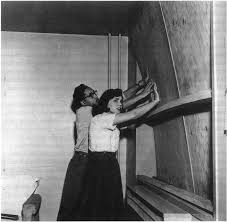
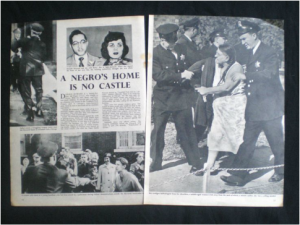
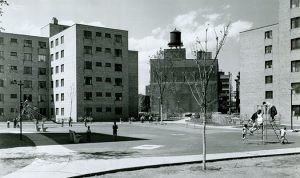
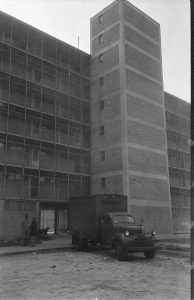
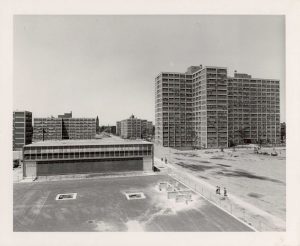
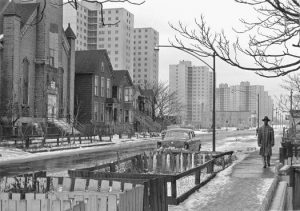

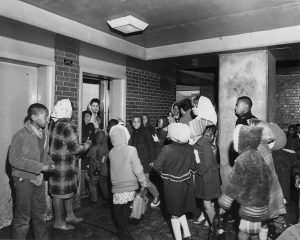



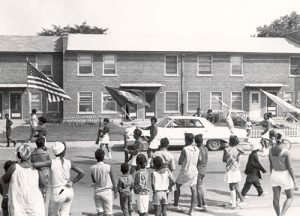
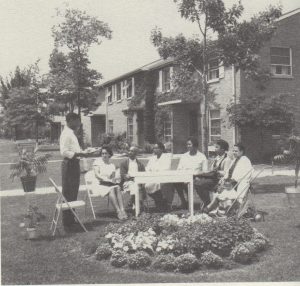
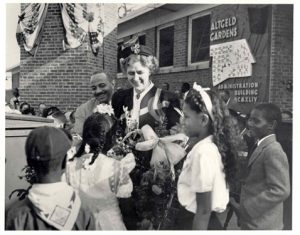
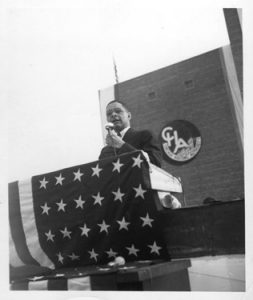
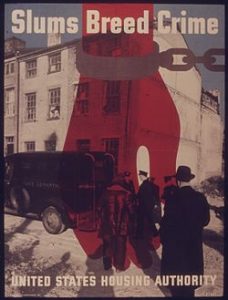
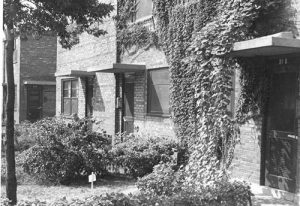
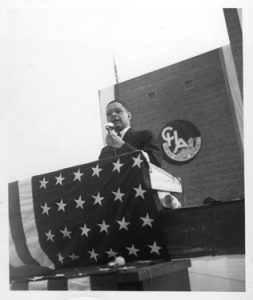


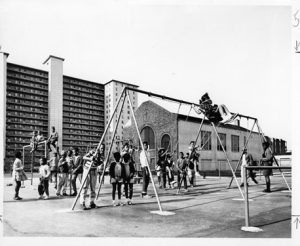

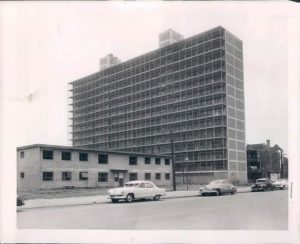
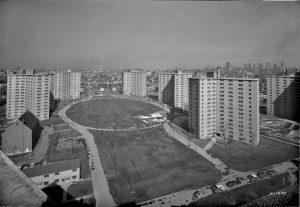
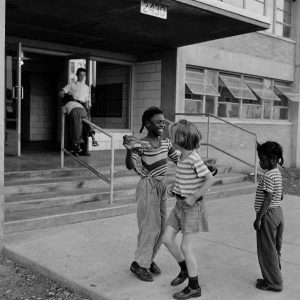
The beginning of the decline
In the year 1963 Charles Swibel was appointed the new Chairman of the Chicago Housing Authority, Swibel just so happened to be a crony of Mayor Richard J. Daley and he also had major connections to corrupt union and political figures. As soon as Swibel took over the CHA budget cuts left and right began and newly arrived tenants were no longer being as carefully screened for employment and criminal records this brought some early issues into the projects as law abiding residents found themselves having neighbors that had shady backgrounds. The crime and seedier resident problems started in high rise projects like Cabrini Green and the Robert Taylor Homes in the mid-1960s as gangs became stronger forces among the youths living in the projects. Gangs have lived in the projects since the 1940s but those gangs were kept under control by watchful residents and many of the youths grew out of the gang life as they got older, if not, they were evicted from the projects. Now there was a new wave of more violent and larger street gangs moving into the projects like Black Stone Rangers, Vice Lords, Egyptian Cobras and Devil’s Disciples that were hell bent on taking over the entire city. These gangs were very violent and fought each other viciously in the court yards and in the project hallways. The teenage gang members were also known for selling small quantities of heroin and cocaine to drug addicted adult male residents.
In the year 1968 Senator Edward Brooke amended the Housing Act of 1968 that put a cap on rent charged by CHA at only 25% or resident’s income, this also allowed residents with very low incomes to move into the projects because now it was considered discrimination not to let them in. On the positive side residents that were horribly underemployed and lived on disability income could finally receive housing, but on the downside some of those residents with disability income had criminal records and poor credit histories or even were known to be drug addicts, but the new laws forbid CHA from screening them out and by 1969 the law was in full effect. The other new rent amendment had rent payment decrease if the resident made less money and increase if the resident made more money. Before 1968 CHA charged a fixed amount of rent for residents but once the new laws took effect, longer term residents found themselves being responsible for paying a much higher rent rate because it was all based on percentage of income now instead of on a fixed amount.
There was no loyalty for law abiding and hardworking tenants that were the lifeblood of the projects, even though they paid the rent that brought repairs and maintenance to the buildings, even though they kept a watchful eye on the community and kept up the gardens, hallways and their own dwellings, there was no appreciation for their valued tenancy. The new laws had a serious flaw that did not stipulate for higher income, loyal tenants to be free of a rent increase, it was likely assumed they would just pay the raised rent, even though the ironic thing is this law forbid the raising of rent for tenants; however, higher income residents got this initial boost. At this point in the late 1960s and into the early 1970s several law abiding and higher income tenants moved out of the projects once they found something better, before, they were not looking for a new place, now they were on the lookout and soon found places that treated them better and gave them more for their money. These residents also did not appreciate the new tenants that were criminals, addicted to drugs or just plain filthy with their habits and the way they lived. Some of the new underclass income residents were poorly assimilated into a decent way of living and lacked basic skills for housing upkeep or they simply had no desire.
In the early days of the projects’ development, newly arrived black southerners were trained by the CHA on basic hygiene, housing maintenance (keeping your apartment clean etc….), use of appliances and how to raise children better. The newly arrived CHA residents were not given this type of training especially since many of them had lived in Chicago for a longer time and were perhaps born here. The living situations for poor southern blacks often forced them into an uncleanly and uneducated lifestyle but now holding a full time job, receiving CHA training and being among cleanly neighbors helped these families function much better and now they expected the same thing of newly arrived residents; however, this would not be the case for the freshly arrived tenants and the best way for these families to deal with the situation was to move out especially since crime was sharply increasing and the gang activity was getting much worse.
The gang wars were becoming much worse in the projects as these large empires were battling for total control and by the late 1960s these gangs were getting a bigger taste of the profits brought from the drug trade which elevated the need to push back the power of rival street gangs. In Cabrini Green gang members were already arming themselves with some pretty heavy artillery as they developed the concept of sniper warfare in these buildings. The idea came about during the Martin Luther King riots in April of 1968 when snipers were gunning down several people from the high rises; innocent people were shot during that incident.
The projects were already starting the deteriorate in the late 1960s because funding was slowing down as higher income residents were moving out and lower income residents were moving in. Those that did not practice good habits with tending to their dwellings and the building they lived in caused the buildings to suffer harder use, thus, accelerating the deterioration. The projects were not safe not only because of gangs but also because the poor construction and this caused CHA to be sued in 1969, the lawsuit forbid the building of any more high rise projects in urban slums and this immediately halted all further plans for new projects effective 1969.
The projects begin the plunge into darkness
As higher income residents continued to move out in large numbers in the 1970s, the CHA found them working with less and less funding to make improvements or to simply keep up on the common repairs needed such as elevator maintenance, graffiti removal refurbishment of the overall appearance of the buildings. Work orders were constantly delayed and one of the worst of those delays was trash chutes that became broken and filled with garbage or elevators that were not working. Many residents were not willing to climb up to 19 flights of stairs to get to their apartment nor should they have had to because the stairwells were already becoming dangerous areas, not only that, a resident and their small children would have to be in very good shape to climb all those stairs especially while carrying groceries or other items with weight and many residents had disabilities due to leg or back problems that made a long climb upstairs impossible.
The elevators were a vital part of these high rise buildings and now the elevators would often take a half hour or more to come pick residents or other times they would never come. The graffiti was out of control and vandals knew this as they spray painted their gang tags on the walls; the graffiti would not be cleaned up sometimes up to a few months. The gang wars became more violent and bloody in the buildings as the super gangs in the city were growing larger and partaking in a larger piece of the drug pushing business. Heroin exploded in use and availability in the 1970s and the money brought from the drug sales made gang members attack rivals like wild animals. Rivals chased each other through the project hallways and beat each other half to death; many times once they caught their enemies they pushed them over the ledge to their death in the breezeways. Gang members would also throw objects from the upper floors of the high rises at rivals in the below outside area aiming straight for the head. They tossed bricks, bottles, stones and even bicycles at each other and many times innocent people were hit with flying objects that crushed skulls and caused many often fatal blows. After an angry family brought their child’s casket into the CHA office in a powerful statement against this problem CHA finally responded by placing steel chain link fencing in the breezeways to prevent gang murders, children falling off the ledge, violence against rivals by throwing objects and intoxicated drug addicts from continuously falling from the ledges. People fell off the ledges all the time in the 1960s and 1970s whether it was gang related violence or an accidental plummet of a child or strung out confused addict. The chain link fencing now gave the high rise buildings a complete feel of being in prison as residents were in cages that were wide open to be viewed by the public, was it really the answer the angry family was looking for when they brought their child in a small coffin into the CHA building? Likely not, residents were looking more for major construction that would close off those hallways but that was no longer in the CHA budget because revenue was not coming in as strong as the 1960s to make modifications and corrupt CHA staff members were allowing a syphoning of funding and investing to land in the pockets of various corrupt government cronies of the mighty democratic machine.
The question now became who could run these projects and keep them inline now that CHA and the police were not doing it? This question was answered beginning in the late 1960s by strong black women that built up grassroots movements that were the voice for pushing tenants and the CHA to make repairs and keep up maintenance. Since the projects were seeing less and less male headed households with duel incomes in the 1970s, the female headed household tenants became the voice needed and acted as male role model figures for demanding change and keeping children in line. Despite the grassroots’ efforts the problems were overwhelming especially since the gangs consisted of mostly male members that were well armed with guns.
The majority of the gang members in the projects were not even residents of the buildings instead they hung out there all the time and sold drugs, these were also the same men that climbed onto the roofs and took sniper positions at rival gangs, this style of gang warfare was increasing as the 1970s progressed, this even led to the sniper style murder of two Chicago police officers in the Cabrini Green complex in the year 1970 which shocked the nation that gangs could get a hold of such high powered weapons and that they would resort to sniper shooting at Chicago police that were not even firing on them. This was a show of power by the gangs and really showed the whole world that they had taken over those projects and even the police were not to be feared, a trespasser is a trespasser, law enforcement or not, it did not matter you were going to die if you were identified as a threat to their operation, after this incident the Chicago police did not come into these projects often unless they were in large numbers which was usually not within the cities’ budget. Soon other high rises in the city began using the sniper method during gang warfare and against the police to show dominance.
As if the CHA could not be any more disorganized and/or corrupt the late 1970s saw the complete end to organization with the CHA and funding went completely south by 1979. Starting in 1979 CHA was now at their peak of corruption in history as the city seemed to completely abandon these public housing units, now many of the low rises and safer projects like the Henry Horner Homes fell into extreme disarray as these buildings fell into becoming the next Chicago slums. Most of the projects were built over the slums for the sake of slum clearance but now they had become the replacement slums. The gangs completely conquered the high rises and even the low rises by the late 1970s and they smashed and disconnected buzz in security systems and they controlled who entered the buildings. The drug trade manifested into something much larger by the end of the 1970s decade as the gangs moved into more of a corporate style of drug pushing.
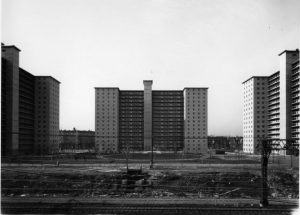
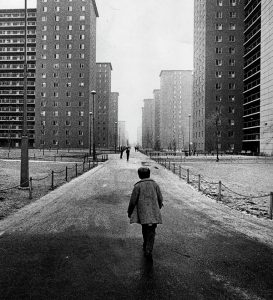
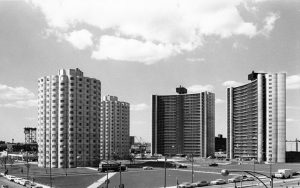





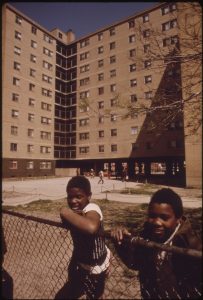
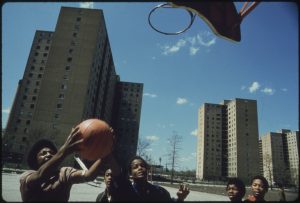

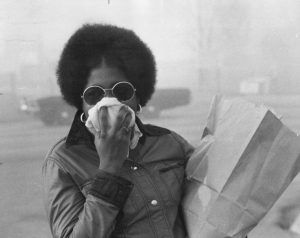
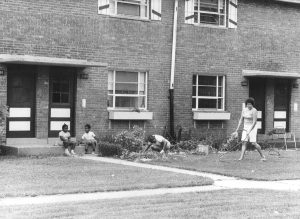




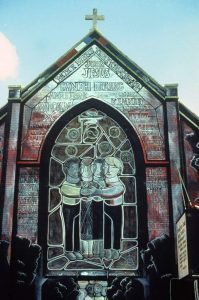




The 1980s
As soon as the 1980s decade rolled in gang wars over drugs in the projects immediately intensified as bullets went flying in all directions. In the first few months of 1981, bodies were dropping left and right during a major gang stand off, this prompted Mayor Jane Byrne to stay in the Cabrini Green high rises for a few weeks to show everyone that once authorities show up the problems will disburse, and sure enough the gang members and transients in Cabrini Green high tailed it out of there real fast and crime dramatically plummeted in the buildings. Residents enjoyed these few weeks of peace but the moment Mayor Byrne left the problems came roaring back. Even though Mayor Byrne’s visit brought major attention to the problems with public housing, law enforcement and the CHA still did not act to fix the problem; however, a buzz was stirred up about just how bad things had become in these buildings and this led to the dismissal of Charles Swibel in 1982 after several allegations of corruption and being a slum lord, but even after Swibel’s dismissal there still was a huge mess to clean up especially the elevator systems that were a complete mess.
In the high rises, the elevators were designed on the outside of the building because they went up to the many breezeway floors that were highly exposed to the nasty Chicago winters. The cheaper elevator models were designed to only withstand warmer climates; it would have cost CHA more money to install well-made elevators that could take a pounding in the colder climate. Frozen urine from the many vagrants and animals that came into the building would cause the doors to either jam open or closed. Not only would the elevators malfunction because of the colder climate pounding down on the gears of the elevators it also called for more expensive and time consuming work orders to fix the elevators which CHA often found funding for such repairs a sluggish process. The next obstacle was the fact that elevator repairmen were often not coming out to do the repair jobs as the contracted companies were pocketing the money for repairs while the workers loafed around and even falsified their time sheets. A major investigation was launched and on January 10, 1984 several elevator mechanics were indicted on fraud charges for falsifying those time sheets and slacking on the work.
The crime became increasingly worse in these projects in the 1980s as shocking crimes were being reported by the mid-1980s like a child being sexually assaulted then thrown from a high rise window as she cried for her mother in 1985 in the Henry Horner Homes, a mentally ill woman was shot to death and left to rot in her apartment for two days after intruders burst in through her bathroom mirror in the Grace Abbot high rises, a 5 month pregnant 16 year old girl that was savagely raped and brutally stabbed to death in the elevator in the Stateway Garden Homes in 1983, a 8 year old boy was tied up and hung from a stairwell banister in the Raymond Hilliard Center in 1988, these shocking violent crimes and more made the newspaper and showed the world there was a major crisis in public housing; however, the public also got the idea that people that resided in public housing were monsters, animals, savages or in racist terms…monkeys, this could not have been further from the truth and CHA workers knew what the real issue was and that was transient gang members, criminals, drug addicts and sex offenders that wondered into these buildings and added to the destruction and disharmony that actual residents raising children were in fear of.
The buildings were now vast majority female headed households raising children on their own and most did not want harm to come to their families but that was very hard to avoid. Living in these buildings was tough for anyone that was vulnerable, the Chicago Tribune published a story in 1985 about a blind man living in the ABLA Housing projects on the west side that was robbed almost daily by thugs because they knew he could not identify them. They even cut holes in his pockets so his change would fall out. They also pried open the bars on his windows and invaded his home to steal his belongings because they knew he could not do anything about it, to make it worse the man did not even own a phone to call police, he had to walk down the street to call the police and by then the police could not help him because he could not identify anyone, this was tough living for the vulnerable.
The single mothers raising several children alone were highly vulnerable and often attached themselves to a gang member that visited the building looking for female companionship, or realistically just looking for sex and a place to hide his guns and drugs. These men hung out in the lobbies and actually waited for newly arrived mothers moving in that just signed a lease seeing this as an opportunity to take advantage. The female would feel protected being with someone from the gang that could fend off potential predators; however, the male would end up in prison, become slain in the streets or would move on eventually, many of times after he impregnated her leaving her with more mouths to feed and once again she was vulnerable to attacks from violent sex offenders and dangerous gang members. Many of times in the process of housing a transient gang member for a while that hid drugs and weapons, police would come knocking on the door then raid the place, once they found the stash it was reported back to CHA and she would become evicted by the CHA for having drugs and/or weapons in her dwelling, which sometimes led her to a life of homelessness and drug addiction after dealing with such a blow, she would often return to the those same projects a few years later this time as a transient addict, this was a cycle that would happen too many times over the years until the high rises were torn down.
In the year 1987 the crack cocaine epidemic became out of control. In 1984 freebasing Cocaine was first discovered as a cheaper and more intense high than cocaine but dealers turned away from it because it cooked up the valuable cocaine product into something cheaper, but by 1985 more cocaine users were discovering that freebasing was a better alternative, and then by 1986 it was being discovered by drug dealers that freebase cocaine smokers became much more addicted than powder cocaine users and so began the epidemic of crack cocaine that swept our nation. By 1987 drug dealers in impoverished neighborhoods and public housing discovered selling crack cocaine was the best way for them to push cocaine. Cocaine was expensive and too hard for vagrants and extremely low income people to come up with money to purchase it, but drug users were able to come up with the money to pay for a crack rock and the money started pouring in as one addict after another became addicted to the rock. The city was already lined up with heroin addicts but many were not into injecting drugs or the effects of heroin but crack was an upper for those that did not inject and wanted to smoke, so now those potential addicts turned out real fast into crack cocaine dependent members of society. Many of the drug users that used powder cocaine when they could afford it switched to crack so they could get high more often. The housing projects were more jumping than ever with crack addicted customers inside and outside of the buildings although most were from outside of the buildings. Once the money started pouring in for dealers and gang members their eyes grew wide once they saw all the cash they were putting in their pockets and the wads got so big they could barely fit the cash in their pockets. This brought more money for higher powered weapons that the gang members used to slay rivals in and all around the buildings, rapid gunfire now echoed all night around these buildings and murders in these CHA buildings reached the highest ever.
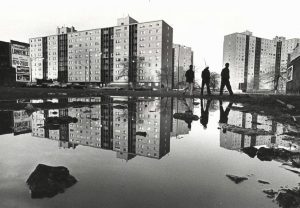
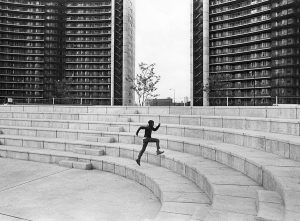

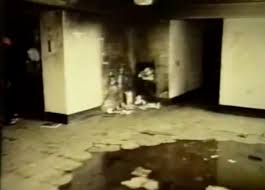
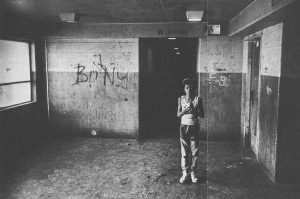
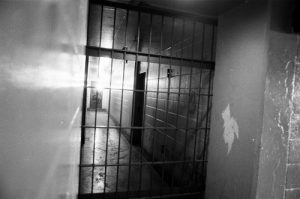

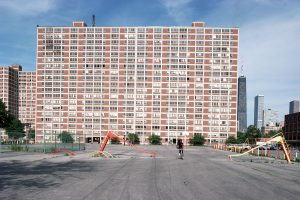
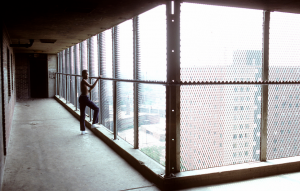
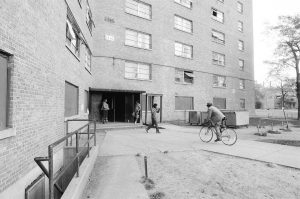

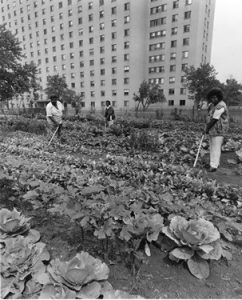
In 1988 the new CHA Chairman Vincent Lane developed his “Clean Sweep” policy that was a program to heavily increase security and police presence in the CHA buildings. Lane’s first order of business was to set up security in the Rockwell Gardens, Prairie Courts and Cabrini Green projects, this anti-drug program was going to cost millions of dollars but it was seen as necessary to stop this ongoing problem. Clean Sweep targeted transient individuals and gang members, anyone not on the lease was told to leave or better yet arrested on the spot for trespassing, this pushed many drug dealers and gang members out of the buildings, this also got many residents thrown out that were found hiding drugs and weapons for gang members or harboring criminals. Arrests were made when criminal records were immediately accessed, if the person had no record they were asked to leave and not come back unless they were invited by a resident. Residents were given ID badges in some of the projects for easy identification of tenants. The efforts of clean sweep continued until 1995 when CHA could no longer fund the process and Vincent Lane stepped down from his position. There were many positives from Clean Sweep in some projects like Rockwell Gardens and Maplewood Courts but other projects like Cabrini Green and Stateway Gardens gang members held security at gun point and threatened to kill them if they interfered with drug dealing activities. In the Madden Park projects gang members opened fire with automatic weapons on a security booth badly wounding the security guard inside in 1988 as an example of how the gangs showed their power. At many project buildings security guards were stabbed and beaten by gangs between 1988 and 1995 but surprisingly only one guard was actually killed. The security guards were not equipped with radios or any communication besides landlines at the booths and in some complexes they did not even carry guns. In the housing projects where security guards were effective residents were happy with the changes and felt free to step outside of their apartments and take their children to the playgrounds, they could even fire up the grill and hang out with their neighbors, but on the downside many reported they could not sleep because the sound of gunfire all night actually put them to sleep because they were used to it, now it was too quite.
https://www.youtube.com/watch?v=4s_iUXhDWB8
Housing projects myths versus facts
Over the years many people that have never lived in the projects have developed biases and have even made cheap or racist jokes about the projects and the people in them. Much of these beliefs and understandings are false or horribly misconstrued. Let us explore some of these myths and the facts that are the truth.
Myth: The projects were full of residents that were criminals, gang members and drug dealers
Fact: about 80% of the actual residents of the projects that carried a lease with the CHA where law abiding citizens or only guilty of very petty crimes at worst. The other 20% were indeed criminals but once they were caught violating the law in the buildings after they signed the lease they were immediately evicted. Many of the children in the projects did become gang members but once they were convicted of serious crimes, their families were evicted, if the child was 18 he or she would only be evicted.
Myth: People living in the projects were filthy people that were too lazy or classless to take care of themselves or their dwellings.
Fact: Most projects tenants were very clean and had organized apartments, those that did not were because of drug addictions they picked up after signing the lease, within no time they would be unable to pay the lease due to addiction and were evicted making their stay after resorting to the new life style short. Most tenants were upset and appalled by the conditions outside of their apartments and many tried to upkeep parts of the hallways. The vast majority of the trash, deterioration, graffiti and human excrement on the floors in the halls and elevators were caused by transient homeless and drug addicted people. Even after clean residents cleaned tirelessly, roaches and other vermin still entered their apartments due to the conditions of the building as a whole that had no reflection on how individual residents lived.
Myth: Residents in the projects are lazy and do not want to work
Fact: most residents were hungry to find employment; however, the areas they lived in had a massive shortage of jobs due to disinvestment in the neighborhoods, competition for the few jobs available was actually fierce as people competed for those few jobs and many of those jobs offered paid a very low salary. Many residents were also blacklisted when they applied for jobs in other neighborhoods once employers found out they lived in the projects because of prejudices that project dwellers were all lazy criminals. Unemployment in many of the projects reached as high as over 90% because of the lack of work offered.
Myth: Project residents cannot be assimilated into regular society because they are filthy, ghetto pigs that have no class because of the lives they once lived.
Fact: many project dwellers were assimilated into regular society through CHA programs after the high rises were torn down. They were given strict guidelines for how to live properly and if they failed the test they were denied housing in other communities, of course there were some cases where some passed the test then lived poorly later in the their new community but the majority fared well and became law abiding productive members of society.
1990s Hope IV grant and HUD take over
Corruption and disorganization plagued the CHA since 1963 when Swibel took over, but things got much worse in 1979 when there was a complete drain on the funding for repairs, maintenance and law enforcement in these projects. In 1982 Swibel was asked to step down but a major mess was left with the public housing system. In 1987 the U.S. Department Of Housing And Urban Development (HUD) began applying pressure on the CHA and Mayor Harold Washington to take over the agency because of the many scandals and corruption allegations surrounding CHA. Conditions in the projects were horrifying and now it was public knowledge and many tales of terror had reached the newspaper and television. Stories of rape, murder, drugs and severe deterioration made many people shocked that such a society exists and now HUD wanted to take control of CHA putting it under federal control to stop all the madness. Mayor Washington and CHA fought hard against HUD in a legal battle that used high powered lawyers, CHA and Mayor Washington won the battle and kept the responsibilities of public housing directly in the hands of the CHA. Pressure came down on CHA to clean up the violence and drug dealing in the projects and that is when Operation Clean Sweep was launched in 1988; however, it was not enough to cut down on this problem, in fact, the drug trade was getting stronger in the housing projects by the early 1990s as gangs were profiting as much as over $45,000 a day in drug sales and on some days the profits climbed above $100,000 in a single day. Gangs were willing to kill anyone that got in their way of the drug empire and this lead to many innocent deaths and drug addicted customers that ruined the project buildings with their filth.
In 1993, the United States Department of Housing And Urban Development granted billions of dollars in federal grant money to cities around the United States to rehab and demolish the worst off public housing developments in the U.S., this grant was known as the Hope VI grant and out of the 6 billion dollars awarded to cities around the nation Chicago received $150 million dollars of that money to clean the problem up. Now that this money was to be awarded HUD did not want to see this money mismanaged; therefore, a second attempt at a takeover of CHA was launched in 1995 and this time HUD succeeded in the takeover and they began immediate review of the conditions of the projects and the areas around these developments, HUD shed light on several socioeconomic, psychological issues of tenants and the conditions of the buildings.
The Socioeconomic issues
As I had stated earlier the high rise housing projects and even most of the row house projects were placed in areas of the city where crime and poverty were much higher than the average. The high rise projects seemed to be strategically placed in rougher areas in the city near slums and red lined communities while many low rises ended up in communities that fell apart in the years preceding their construction, the end result was thousands of poverty stricken Chicagoans stuck in dangerous communities that had severe socioeconomic problems that had been dis-invested before or during the buildup of the projects, this lead to poor education opportunities and a severe lack of employment opportunities in these communities.
Most people that lived in the projects by the 1980s could not afford to commute to work on a daily basis and even if they could there was not a hot demand for unskilled labor like there was in the old days before the cut back on manufacturing starting in the 1960s. By the late 1970s much of the south side of Chicago was economically devastated by the loss of many factory positions and the closing of many steel mills that employed many unskilled workers. By the early 1980s much of the south side and the west side were virtually bankrupted because of the loss of these jobs and residents in the projects faced incredible unemployment. Residents now had to rush to the nearest low paying jobs in the community nearby competing against several other applicants all gunning for the same jobs, but the few companies that were hiring could only take in a few people, there just was not enough employment to go around to the thousands of residents in public housing in the community.
The neighborhood around the projects consisted of burned out slums with rows of dilapidated and shuttered buildings. Most industrial plants had long been closed down and now housed vagrants and drug addicts. For miles around the public housing projects it was the same scenario of run down impoverished neighborhoods that suffered the same economic disinvestment. Finding work in other parts of the city was very difficult due to the lack of resources to find out about open positions, especially since we are talking about a time before the internet was developed for home use (before 1995) and even when it was nobody in the projects had access to the internet because it was too costly and since this was before 2011, internet was not standard on cell phones yet, it was still a luxury for affordable phones. The areas lacked public libraries and any other resources that had internet connection because the area was horribly dis-invested, such resources did not appear until the later 2000s decade or by the 2010s when neighborhoods like Douglas, Grand Boulevard and Washington Park ended up with libraries and many brand new public service buildings but before the later 2000s these three communities were a desert for such facilities.
Temp agencies were not common place in these communities that had housing projects because temp agencies are privately owned entities and only have interest in opening in areas where they can find job placement in the immediate area, since the neighborhoods where public housing stood had very few opportunities, temp agencies found no interest in setting up in those communities because they were not profitable. They also knew much of these communities had several individuals that would not turn out to be reliable workers which could damage the reputation of the temp agency. One might ask why these people did not just get on the EL or the bus and find jobs in downtown Chicago or the north side. Many of times residents were so poor they could not afford the public transportation fare or own vehicles, especially since it is common knowledge that job hunting would involve several trips to the area of interest filling out many job applications, it can rarely be taken care of that same day when a project dweller will make a trip downtown, fill out apps and get a call back from the apps they filled out that one day, the day they managed to come up with the money for the EL and bus fare, now try multiplying that transportation fare by 5 or more days for trips to downtown to fill out more job applications, now we are getting pretty expensive especially when your income is zero or only up to $5,000 a year and you have several children to support. Many project residents found it difficult impressing job interviewers because they lacked impressive clothes to wear for the interview, we are not talking about a stereotypical and mythical project resident that has all this money from hustling, no we are talking about the vast majority of project residents that truly had no money and no nice things, unlike what most people believe that they stole and hustled to get nice clothes and jewelry, those assumptions are mostly false and distracted the rest of society away from the real problem. Many of times hiring managers were wise to were public housing projects were located and when they researched the address on the application they would find out the person lived in the projects and would not hire them, of course such a practice is illegal; however, if the hiring manager was to tell the applicant a different and legit reason for not hiring them such as another more qualified candidate came along then the manager could get away with it.
Another problem with commuting to job hunting sites and also even holding down a job for the many project single mothers was where to put their children while they were away looking for a job in a faraway community or if they found a job where would their children go while they were at work? These single moms could not afford day care and yes, many had relatives that could watch the children but many of those relatives held down jobs or if they did not they did not live in the neighborhood which would involve busing the children to another community then having enough time to take public transportation again to get to work. Many of single mothers did use this option and bused their children to relatives’ places to watch their children while they worked but for many that was not an option especially if all their relatives lived in other dangerous communities or were unable to take care of children. Many of the older children in these larger families were old enough to stay home alone and even watch over the younger kids but because of how dangerous the projects were with all the shootings and rapes and how unsafe the fixtures were on the windows and heaters many mothers were too scared to leave their children alone in the projects. Would you leave your children alone in the high rise projects? If you answered in your head no then there is no need for further criticism. Children were sometimes abducted and/or sexually assaulted by transient guests that wondered into these projects. Many of the project apartments could be easily broken into and mothers did not want to think about someone breaking in while they were not home, because who knows what the burglar would do to those children.
Another major factor that prevented many project residents from finding employment was the lack of a basic need that most people had in their homes but projects residents often could not afford it; this common household item is a telephone. Many residents could not afford to pay a month to month telephone bill, so if they applied for a job there really was no way an employer could call back. Sometimes residents were able to leave a relative’s phone number as a call back number but many times the relative may not be reliable or many of times their relatives did not even own a phone, this made the job hunt almost impossible especially after the project resident already had other factors stacked against them.
Holding down a job and finding a job became nearly impossible for project residents especially in the Douglas, Oakland and Grand Boulevard neighborhoods where jobs were extremely scarce, this affected such projects as Ida B Wells, Dearborn Homes, Prairie Courts, Harold Ickes, Stateway Gardens, Robert Taylor Homes, Clarence Darrow Homes, Olander Homes, Washington Park Homes and Madden Park Homes.
The Near West Side fell into a slum by the 1970s and did not improve until the later 2000s decade which caused the scarcity of employment in this area that affected the following projects: Jane Addams Homes, Robert Brooks Homes, Loomis Courts, Grace Abbott Homes, Henry Horner Homes, Maplewood Courts and Rockwell Gardens. Other projects outside of these two clusters were still located in areas where industry collapsed and jobs still were scarce within miles in such west side and south side projects as: Trumbull Park Homes, Lawndale Gardens, Lowden Homes, Wentworth Gardens, Altgeld Gardens/Phillip Murray Homes, Parkway Gardens, Ogden Courts and the Harrison Courts. All these scattered projects were in neighborhoods that all suffered economic decline within miles of their location. Public housing projects that were put in better locations with thriving communities would fare much better and had some higher income residents in projects such as the Julia C. Lathrop Homes, Bridgeport Homes, Leclaire Courts and the Raymond Hilliard Center. These four projects were built in mixed income areas and were right near shopping and industry which further proves that location is important to the well being of project residents. Jobs have to also be obtainable for project dwellers, hence, was the problem with Cabrini Green, even though it was located right next to down town Chicago many of these businesses were higher paying office jobs or higher class retail establishments which made it tough for project dwellers to fit into this type of a work force and actually made them unwanted especially since Near North Side and Loop hiring managers were more familiar with Cabrini Green addresses since they operated less than a mile away from the projects and many stores unofficially blacklisted project dwellers for fears they would steal from them or get involved in crime even if their background checks came back clean. Many hiring managers did not want someone from this area in their place of business because they had an image to uphold and felt the project dweller would not fit in with that image because they served higher clientele and business men and women. Even though much of this discrimination was illegal a hiring manger could always make another reason, the official reason for not hiring the project dweller.
The psychological effect
The majority of Chicago’s housing projects were in a serious state of deterioration, full of violent gang warfare and the high rises were designed to look and feel like prison. Bars in the hallways, bars on the windows, chain link fences in the gallery style breezeways gave a feel of confinement and being sentenced and trapped in a ghetto prison because one is poor and not worthy of assimilation into normal society. The galleries could be used as displays of people living in this nightmare and also a look at the criminal elements that wandered through the hallways. Many times tours were taken to these projects by private groups that wanted to show a tour what the projects were like, and suburban types would stare in horror at the living conditions from the outside while residents watching had to feel like animals on display at the zoo.
The poor design of the buildings not only brought on drab feelings of being trapped in confinement, the poor structure also allowed transient criminal elements easy access into these buildings to wreak havoc and take control of the residents that lived there. The gangs basically assumed the role of prison guards as they enforced curfew on residents and made them feel uncomfortable to leave their apartments even before curfew hours. Intimidation, poking fun, uncomfortable gawking, lewd comments, drunken behavior and uncomfortable conversation were ways criminal elements and gang members kept residents uncomfortable from leaving their apartments as the gang members and drug addicts taunted residents for going about normal daily activities. At night the uncomfortable taunting turned into violent behavior if residents exited their apartments after curfew, sometimes a vicious beating other times being shot and killed were the punishment for leaving your apartment.
In the United States of America we have a society where we are not controlled by a dictatorship and we are free of warfare at our doorstep. We do not have soldiers entering our homes mistreated us and demanding shelter as they point guns in our faces, this is all guaranteed in the Constitution of the United States. In the Chicago public housing projects those comforts that most of us take for granted were non-existent as project residents lived as if they were in a third world country that was war stricken such as seen in many middle east and eastern European countries where warfare is a part of daily life and survival is a challenge while people live in the worst conditions. Residents living in the public housing high rises lived almost the same exact life style, but why? This is the United States how could this be? The basic answer is that these buildings were largely forgotten by society and large tax dollars were needed to clean the problems up the CHA “did not have,” there was not enough budget to put police officers in heavier patrols in these building, there was not enough budget for advanced security, there was not enough budget to make the buildings safer through renovation, there was not enough budget to help the community rebuild around the projects, budge, budget, BUDGET! That is what it was all about, money, the money that was reserved by the government to use for public housing was determined by the demands of society, what the priority really was, is to not pay attention to this nightmare, city of Chicago did not slice off enough of budgeting funds to help the projects, or did they? Many documented scandals have floated around throughout the years of CHA mismanagement of funding which prompted the HUD takeover in 1995, so if there was mismanagement the question becomes of who truly benefited from that funding, there has not been much evidence of exactly where the money went but there have always been heavy suspicions the money went into private interest or was perhaps embezzled?
Any way you want to look at it there was a financial drain for helping these communities and because of the lack of attention paid to these buildings armies of armed gang members were able to storm these projects and take them over by force just like militant groups do in third world countries. The buildings were seized by gangsters for the purpose of drug profit and in the midst of it the buildings were turned into large crack and heroin dens where addicts could use drugs and sleep there freely. Some addicts could also use residents and other addicts as targets for any of their greedy or perverted schemes such as rape of women in the hallways or elevators when they were strung out or perhaps robbery of residents and other addicts to get money for more drugs; however, most addicts were harmless and simply slept in the hallways and released their human excrement wherever they felt like, giving the buildings the smell of rot and of a sewer.
The addicts also had control of the buildings, the buildings were in control by the drug dealers and their customers, basically drugs controlled the towers. The buildings were in a state of complete lawlessness and anarchy; therefore, criminals of private endeavor were free to come into these buildings and indulge in their escapades without any fear of reprieve or punishment of any sort.
Criminals stacked out vacant apartments that were next to occupied apartments and began their entry through the walls whether it means slithering through the mirrors in the bathrooms or violently kicking down the dry wall, once inside they set their adrenalines high especially if intoxicated on PCP and would proceed to beat, rape or even murder anyone that was inside and snatch anything of value, some burst through the walls looking only to rape as they targeted single female victims that were violently attacked as their children watched in horror as this frightening man suddenly burst through the wall. Although these types of break-ins were not common occurrences they were still frightening to those that lived in the same buildings when it was heard about and they were still common enough to happen more than once a year in a single building.
The drug trade had the high rises on complete lockdown as gang members regulated if people were allowed to come and go. Many times residents invited guests over but those guests would sometimes get turned away by gang members or charged a toll for entry. Residents were also subjected to pay a toll at random times if an individual gang member felt like it. This was not a tax imposed by the gang on residents it was tax a certain gang member holding a gun felt like imposing. Residents were also subject to be searched by armed gang members as they entered the buildings and this was not a search procedure like the police would do where they would have a female search other females instead these were searches done by all males. Gangs did not permit excessive groping or sexual assault during searches or punishment would be administered to the gang member; however, some would still touch a little inappropriately and if a resident complained it was swept under the rug or that gang member would get revenge on that resident for snitching. Even though most searches did not involve improper touching many residents still felt violated especially since the searches did not benefit resident’s safety instead it was meant to assure the safety of the gang only.
If the gang felt under attack they would often lock the front entrance doors and sometimes not let residents into the building, imagine being turned away from going into your own home. The searches, harassment and the hallway dwelling addicts made residents often too afraid to go downstairs to check their mail, that is if they even received mail because many times postal workers skipped delivery in these buildings out of fear.
Nothing was as traumatic and as common as the gun fire in and around the buildings. Gang members fired guns at each other wildly as many were young and not trained in how to fire these weapons especially if they were shooting automatic weapons or various how powered weapons. Bullets tended to spray in all directions and many times they whizzed in through the walls of resident’s apartments. Every resident of the more dangerous projects had bullets enter their homes, and the vast majority had several bullets enter their homes. Some of the stray bullets were from shootings in the hallways but most of the time the bullets came from outside, sometimes from shootings in the streets. Residents developed procedures for themselves and their families to follow in order to avoid being struck by gunfire that usually occurred at night. Many residents and their children slept on the floor to avoid being shot through the walls. When shootings occurred many residents fled into the closets and the bathtubs during gun battles that pelted the outer walls and windows of the buildings. Many stray bullets struck people in their apartments, many times little children were the victims. Too many times a small child was stuck through the walls and even tiny infants were hit during gun battles, the families could do their best to avoid the bullets but sometimes the first bullets were the hardest to avoid. The danger of being shot or dealing with your children getting shot was heightened when out on the streets right outside the buildings.
Children had to be escorted to and from school because gangs would often break out into gun battles in broad daylight and start shooting everywhere. The sniper shootings from on top of the high rises were the scariest because the youths firing those weapons had no control of these higher powered rifles and the intended target was often not hit, many children were picked off during these sniper attacks. Gang members felt compelled to shoot their rivals whenever and wherever, regardless, if there were children present. Many did not want to shoot when children were around but they knew the enemy did not care and was going to shoot at them anyway so it was kill or be killed. Parents of the children instructed their kids to duck down as they walked when they approached the project buildings because this time of day would often be prime time for gun battles due to the fact that many teenage gang members were walking home from school and once they saw each other they would shoot at each other.
Children were accustomed to gun fire and were even able to tell the difference between gun fire in the distance and a firecracker or another exploding sound. While many children around this country were boasting that they knew the words of their favorite cartoon or knew all the features of an action figure set, project children were able to tell the difference between gun fire and not, which is usually a feature that trained military, gun collectors, or law enforcement adults only have knowledge of, but the fact is these children were living in a war zone much like a war stricken from a third world country and they were scared every day. Having fear on a daily basis can cause serious psychological trauma and according to experts this can lead to a severe inability to learn at a proper pace, which is why many children from the projects were often held back in school many of times up to three or four grades back until many would drop out.
Many children suffered depression and would face bullying by other children that were gang members. There was a lot of pressure to be a gang member that especially effected children 10 years old or older. Children in the gangs would often harass law abiding children daily and even inflict physical violence on them attempting to force them to do bad things or join the gang; these children would finally drop out of school for fears of violence from bullies. The popular belief is that most children from the projects join gangs and end up going down a bad path of a destructive lifestyle, such beliefs are not true at all, in fact, most children were law abiding and were victims of neighborhood violence, most avoided gangs and drugs; however, most would also end up not amounting to anything in life except being unemployed and hopeless when they grew older, taking small jobs here and there if they could find them. The neighborhood and the surrounding lifestyles did not offer much encouragement or opportunity for these children and they would grow up lost, many did indeed end up resorting to a life of crime and gang activity, the once scared project child would end up becoming the predator in later years until he ended up dead or in prison.
If you have ever heard the term “Don’t shit where you eat” it means to not destroy your surroundings where you live instead you do it elsewhere. This was very true in public housing in Chicago, 80% of people that lived in the projects did not shit where they ate instead all the shitting both metaphorically and literally was done by transients from the outside. When I use the term transient I am not just referring to homeless people because the term is actually broader than referring to the homeless, it mainly refers to anyone that hangs out near someone else’s property. Gang members from other parts of the south side and west side came to the projects everyday just like how an average citizen goes to work every day. Gang members came there to work a drug dealing shift and/or work a security shift. Just like an employer expects you to come to work every day or you will be punished, the gang forced their members to clock in every day or they would be punished. Sometimes gang members did not want to be a part of this system of project takeover and tried to say no, but once they did they were beaten severely or shot dead for disobedience. Not only were residents of these projects forced to deal with the day to day operations of this drug trade gang members that were a part of it were forced to deal with it too. Many of the gang members had no issue with dealing with it especially after their pockets were filled with cash. The gang members would often unofficially move into the buildings after they would declare courtship with a young single mother, he would then be able to stash his drugs and guns in the apartment and also receive sexual gratification from the mother, which was until the mother would lose their apartment or the gang member was killed or incarcerated. Many of times he would move on if he got her pregnant because his arrangement to begin with was mostly for business and pleasure and not for love despite the fact that many times the young mother was led to believe otherwise. Many times the commandeering of a project resident’s quarters was not an invited act, many times a gang member would threaten a resident if they did not hide guns and/or drugs in their apartment the gang member would kill them. Law abiding residents sometimes had to deal with having large amounts of drugs and guns hidden in their apartment for up to a few months. The mothers were worried that their children would find the stash and hurt themselves with the guns or drugs, they also worried if the police did a raid and found the stash the mother would go to jail and loose her apartment and children. Because there were a lot of single women harboring gang members voluntarily and because many gang members had relatives hiding stashes voluntarily police could not tell the difference between who was deliberately hiding the stash or who was coerced into it, nor did the police even care to find out they would just take everyone to jail and the CHA had to evict that tenant for violating the lease. We all read in our history books that during and before the Revolutionary War citizens were forced to quarter British soldiers, which was one of the reasons for the war, comparatively residents in the projects were often forced to quarter gang members for sometimes a few weeks at a time, gang members could sometimes demand someone let them live there for a while or face consequences.
Many residents of the projects lived a life of extreme duress as worrying about basic survival became a major issue for their daily lives. When people are under extremely stressful situations on a daily basis it can cause wear on the body. Depression and stress can cause aches, pains and even debilitating conditions on ones’ physical health. Many of those that lived in the projects ended up on several medications for pain, depression and cardiovascular disease. Many had high blood pressure and heart problems from the everyday stress of the environment they lived in. Some tenants that had family genetics of mental illness would often have those disorder tendencies accelerated to arrive earlier in life, in greater intensity or would have a better chance of developing a mental illness due to extreme duress caused by their surroundings. Not only were the projects physically a danger they also were mentally a danger as several health issues could develop from dealing with these day to day stresses. Many residents took to the use of hard drugs as an escape from the evils of the projects and the stress of not having financial stability. Almost every public housing resident was on some form of public aid and often the health insurance offered through public aid did not offer many medicine discounts for those that had certain forms of mental illness this often led to drug use because it was much cheaper than prescribed medicine for mental illness.
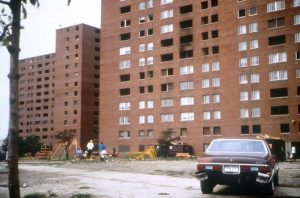
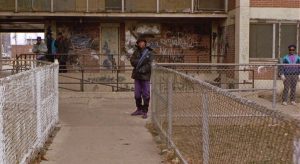
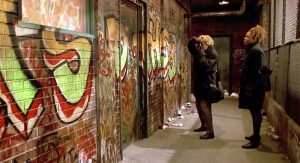
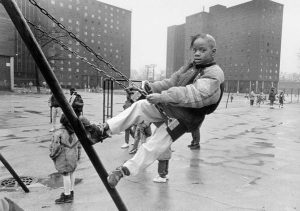
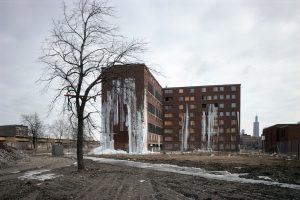

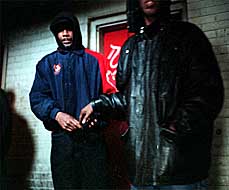
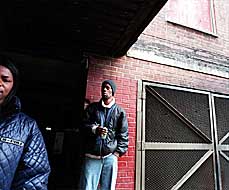
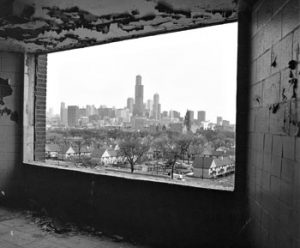
The Conditions
The high rise public housing projects operated for many years in living conditions that would cause privately owned homes and buildings to be condemned by the city but since this was city funded public housing the buildings were allowed to stay and house people for many years. When the conditions were fully surveyed by HUD housing staff in the 1990s as they were making decisions whether to tear down or rehab certain buildings what they found was truly horrifying and likely the filming staff of the 1992 movie Candyman felt the same way when they entered the Cabrini Green high rises for the filming of this classic horror film. The Cabrini Green high rises and all the high rises in Chicago were indeed like scenes from horror movies as residents lived in fear and anguish in these hellhole ghetto prisons of death and dismay. The list of severe conditions of the projects can be quite lengthy some of the most notorious are as follows:
Bullet casings fill the sidewalks. The gang wars on the outside of the projects were vicious and gang members were well armed with automatic weapons that had magazines that could carry up to 50 rounds attached to such weapons as AK-47s, Uzis, Tech Nines, Mac 10s, Mac 11s and AR-15s. Guns were fired on a daily basis every night, several times a night and much of that gunfire was semi – automatic and fully automatic gun fire that spat out several casings per minute. The sidewalks and gutters were filled with spent cartridge shells, a form of litter not seen in urban or suburban environments, usually only on battlefields.
Drug needles and crack vials fill sidewalks and lobbies. Another form of usual trash found in and near the projects were spent drug needles and empty crack vials that were discarded by the transient addicts that came and went in these buildings. When the lobby doors would be opened and a gust of wind blew often scores of empty crack vials would clank on the ground and come rolling forward. Empty hypodermic needles from heroin users disposed of on sidewalks, playgrounds and lobbies posed a danger for children due to a threat of injury or the many diseases the needles had on them that were usually Hepatitis and HIV.
Stolen mailboxes. Transient criminals entered these project buildings and tore off resident’s mailboxes in order to sell the metal as scrap metal; usually drug addicts did this to make money for drugs. Residents then would not receive their mail as a result, when the residents would complain to the CHA for new mailboxes it often took weeks or months to get replacements especially before the HUD take over.
Graffiti. The buildings were covered in graffiti, mainly on the inside of the buildings where obscene or gang related graffiti was spray painted or carved into the walls and pillars. Gang members often marked buildings with five or six point starts to show which gang owned a building. Six point stars referred to Gangster Disciples and Black Disciples, while five point stars referred to Black P Stones, Mickey Cobras, Four Corner Hustlers and Vice Lords. Graffiti became a problem in the 1960s and became out of control by the 1980s as the buildings became saturated with it. Vacant apartments were covered in gang graffiti as well, making the apartment more costly to repair and left to be vacant longer.
Vacant Apartments. Not only were vacant apartments a financial drain on CHA revenues because no one was paying rent, they were also a danger to these buildings. Drug addicts and criminals broke into these boarded up dwellings and carried on with illegal activities. Gangs opened up crack dens in these vacant dwellings for addicts to hang out and get high. Gang meetings were held in these apartments and they often stashed drugs and weapons in these rooms. Criminals were able to easily break into these vacant apartments then smash through the walls into an occupied apartment so they could either rob occupied apartments or rape female tenants.
Vermin swarmed in these vacant dwellings because there was no maintenance due to the vacancy, addicts and other squatters made messes leaving food and excrement that caused more vermin to be attracted to the dwelling. Appliances had to be removed because the property would be stolen if left in the apartment even if the door was boarded or locked up.
Vermin. Roaches and mice have always been a major problem for public housing high rise structures since the 1950s; however, constant maintenance kept the problem at bay during the 1950s, 1960s and most of the 1970s. By the 1980s budgeting did not permit the constant upkeep to deal with vermin and thousands of cockroaches, rats, mice and stray cats could be seen on a daily basis in these projects. Many residents struggled to keep their individual dwellings clean; however, other residents did not, and the hallways, stairwells and lobbies were not kept up as trash and excrement attracted vermin that spread disease and more excrement. Entire walls in and outside of tenant apartments were covered with mice, rat and cockroach droppings that hardened and caked onto the walls. The excrement from these creatures was toxic and also expensive to remove after it hardened onto the walls because it ruined paint and caused walls to further rot. Children developed Asthma or had pre-existing Asthma conditions become worse because of massive cockroach infestations.
Trash. The project hallways and lobbies in the high rises were littered with rotting trash that emitted foul odors. The trash chutes were often backed up and broke often due to poor construction which caused mass overflows of waste. Trash was often not even taken to the chutes by transients in the buildings because of a lack of personal regard for the well being of those that resided there. The hallways and lobbies were often filled with up to 50 transient addicts and gang members on a daily basis that discarded trash everywhere. The elevators and stairwells were also lined with rotten trash. The trash attracted several stray cats, rodents and cockroaches. The broken and backed up trash chutes also posed a fire hazard and very often caught on fire which posed another hazard in the buildings.
Metal bars in the hallways. As a method of crime control, sets of metal bars were put in certain parts of the hallways, the problem these bars caused was it gave the projects a depressing look of being in prison and also made the buildings look more dangerous and offered less fire escape options.
Breezeways. The project hallways that led to apartments were designed to be open hallways directly into the outdoor weather elements. The design was originally intended for residents to enjoy nice weather days outdoors like having a porch and for the allowance of solar energy to save on building heating and air conditioning costs to individual apartments due to the fact that right outside the resident’s front doors was the outdoors. This design termed “Galleries” attracted drafts and undesirable heat and cold from the outside, although economically efficient for the hallways, climate control in the apartments was not efficient for the comfort of residents but since the heat and air was building controlled residents were not able to control their own climate control.
The open breezeways were also a danger in the earliest days of operation as children and addicts were accidentally falling to their deaths from the ledges, then violent gang members threw rival gang members off the ledges or hurled objects from the top floors causing several injuries and/or death. CHA installed metal chain link fences to enclose these hallways to prevent these problems but residents ended up with an imprisoned caged in feel. Eventually many of these chain fences broke in certain spots and more people began falling to their deaths.
Elevators. Elevators were mandatory for the high rises as flights of stairs were too harsh for small children. Many residents were also aging and/or disabled and unable to climb several flights of stairs. The elevators were designed with cheaper materials and were built in the most cost efficient manner. Most elevators in buildings in general are indoor units and in order to operate an outdoor elevator must use more expensive materials and more costly engineering is required during construction in order for the elevator system to deal with outdoor elements especially when the elevators have to deal with harsh Chicago winter weather. The project elevators were only fit for indoor use and not for use of moving from one breezeway to another. The elevators were constantly exposed to the outdoor weather and took major punishment from the elements. The elevators needed constant repairs that turned out to be costly and difficult repairs that often extended outside of budget costs which brought slow repairs.
Because the elevators were in such bad shape the elevators would take sometimes up to an hour to arrive after being called. Many times elevator doors would not open or not shut while riding the elevator. Many times the doors were left open when no elevator was on that floor which caused many children and intoxicated drug addicts to fall down the elevator shafts. Gang members would also throw enemies down the shafts as well. The doors were often frozen shut or frozen open due to the malfunctioning door runners caused by weather or because of frozen puddles of urine that would need to be dissolved with strong chemicals.
Vagrants and addicts often urinated in the elevators soaking the floors and causing terrible odors. Because the doors leading to the shafts were often stuck open gang members would hide drugs and guns on the tops of the elevators. Gang members also made residents pay tolls to ride the elevators at times. At the tops of elevators predators gained easy access inside the elevators to unsuspecting female victims who brought many cases of sexual assault and rape to many young women.
Stairwells. The stairwells had faulty and deteriorated railings that often gave away causing a falling hazard. The stairs were also poorly lit and bulbs were seldom replaced. Many children and elder residents fell down on the stairs due to faulty hand railings and the inability to see well in these darkened areas. Lurking predators hung out in the stairwells that robbed or assaulted people and where able to hide due to the darkness. Stairwells were also filled with trash and human and animal excrement.
Hallways. The hallways were poorly lit and full or lurking predators and intoxicated addicts. Graffiti saturated the walls and many gaping holes and knocked down walls were common sight. The hallways were lined with rotting trash and human excrement. Walls had severe paint chipping and rotting ceilings that leaked water from various plumbing leaks. Many sexual assaults, murders and robberies happened in these darkened hallways because of poor lighting and a lack of security. The hallways had a lingering strong urine smell.
Individual apartments. Although many tenants tried hard to take care of their apartments and keep them clean there were still numerous problems that were beyond the tenant’s control and were not damages the tenants caused or could afford to fix. Many apartments were in bad shape from terrible tenant use but we are only exploring the damages and issues that were from CHA neglect.
The heat and air conditioning were building controlled and residents did not have the ability to adjust the temperature in their apartments. Sometimes the heat ran too high making residents very hot, residents would resort to opening windows or opening their front doors to let in cool air; however, this often posed a high risk for tenants.
Open windows had no screens or window guards which would often cause small children to fall out of windows especially if a baby crib was near a window. Open front doors ran the risk of intoxicated transient drug addicts to wonder inside the apartments which made removal of the addict difficult for single mothers; with the door open was an invitation for criminal elements to force their way inside, sometimes causing violent crime. Broken windows were never repaired or replaced; many times they were just replaced with cheap plastic sheeting. Many times the building heat did not work in the winter time or air conditioning did not work in the summer time leading residents to be in sweltering heat or subzero freezing temperatures. The fact that the high rises were constructed to have apartments leading to outdoor breezeways subjected their dwellings to harsher heat and cold conditions from the climate, when heating and air did not work it posed a health danger to tenants, opening doors and windows to alleviate the issue would pose another risk.
When heat was working radiators were not protected and many children burned themselves on the scorching radiators causing severe injury or 1st to 3rd degree burns. Children were also susceptible to lead poisoning and asbestos poisoning as many of the old project buildings were made with materials that were later deemed poisonous. Most housing facilities were required to replace lead and asbestos in buildings but CHA projects often dodged that requirement and many residents developed cancer from asbestos and children suffered severe cases of lead poisoning. Paint was peeled in advanced stages on the walls and ceilings, the walls were also damaged by water, insect feces and black mold which posed another health hazard were caked onto the walls and ceilings.
Water leaks became common place inside apartments that went unfixed leading to more threats of black mold development. Many of times walls and ceilings partially collapsed leaving gaping holes inside of apartments inviting easier access from vermin and more exposure to black mold poisoning. Residents were often promised several repairs by the Chicago Housing Authority that was not followed through.
Excrement. The high rise projects especially were saturated with urine, feces and vomit. Urine from transient drug addicts and vagrants was the most common as these transient guests urinated on walls and on the floors of lobbies, stairwells and in elevator shafts causing the buildings to have a continuous odor of stale urine. Transient tenants also defecated in hallways and lobbies on the walls and the floors, wild animals such as rodents and wild cats also defecated in the hallways, stairwells and the lobbies. Drug addicted transients and vagrants often vomited in lobbies, stairwells, hallways and in elevators if they became over intoxicated. Many times residents succumbed to human excrement on or outside the doors to their apartments, causing residents to have to clean the mess themselves. Excrement waste would sometimes be left for weeks or months before it was finally cleaned, the worst cases were in the high rises.
Demolition, and life after the nightmare
After the Hope VI grant was bestowed upon the city of Chicago, immediate planning was put in place of how to fix this public housing nightmare that cost so many lives and ruined many other lives. The conditions were all now well-known and especially the high rises were a major public health threat and a threat to the safety of those that lived inside and around the projects after the drug empire operated by violent street gangs had taken over the buildings. Gangster Disciples, Black P Stones, Mickey Cobras, Vice Lords, Black Disciples, Four Corner Hustlers, New Breeds and Latin Kings (Lathrop Homes only for Latin Kings) had a stranglehold on these public housing developments and were willing to kill anyone, even police that threatened to close their operations. HUD and the Chicago Housing Authority sat down to map out what the overall plan was going to be, which buildings would be saved and which were too far gone and would need to be demolished. All these questions needed to be answered; however, it was impossible to figure all of it out in the mid-1990s, it was clear this project would span for over a decade but there was no question that the high rises were a mistake to begin with and were now doomed as these buildings were unfix able.
In September of 1995, the wrecking ball arrived at the first and worst public housing high rise project in Chicago, the Cabrini Green high rise projects. The first building was knocked down at 1117-19 N. Cleveland Ave then later in the year 1157-59 N. Cleveland was torn down. These two Cabrini Green high rises were the first project buildings to be torn down in the city after the Hope VI plan went into effect.
The Cabrini Green projects were the most notorious and considered the most dangerous in the city, so it was no wonder why they were the first buildings slated for demolition. In 1996 more high rises in Cabrini were torn down and demolition began in the Clarence Darrow Homes and the Henry Horner Homes as these were both very dangerous projects.
In 1998 demolition began on the Robert Brooks Homes and the notorious Robert Taylor Homes. In 1999 the Madden Park Homes began demolition and then by the year 2000 the Prairie Courts, Ida B. Wells and Stateway Gardens began demolition, it was also by then that the Clarence Darrow projects became the first projects to be 100% demolished.
The Robert Brooks high rises and Prairie Courts completed demolition by 2001 and demolition began on the notorious Grace Abbot high rises. In 2002 all but one building in the Jane Addams complex were torn down. Demolition started on the Rockwell Gardens in 2003. In 2005 the Ogden Courts were torn down and the Madden Park Homes were completely torn down.
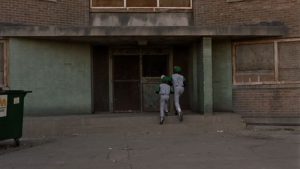
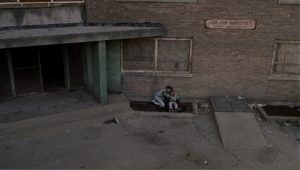
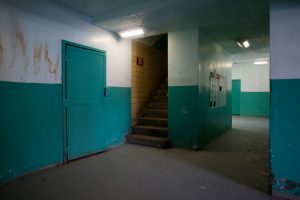
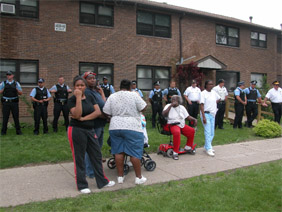
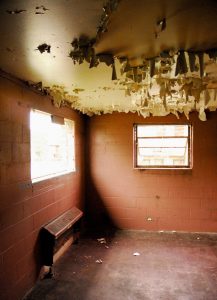
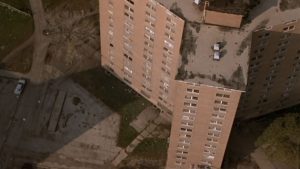
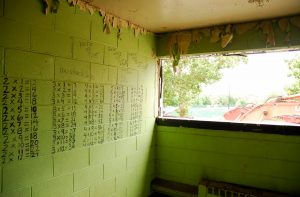
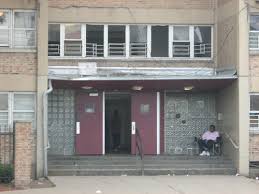
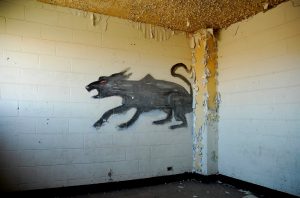
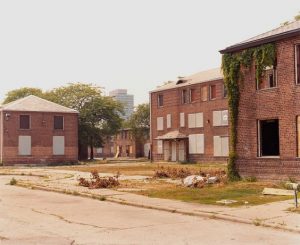
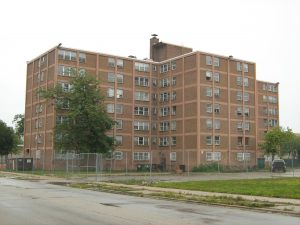
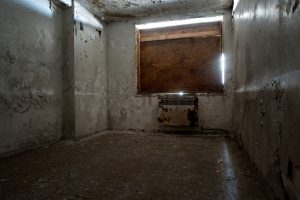
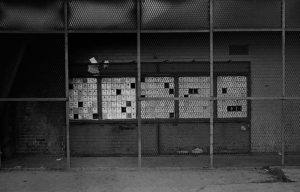
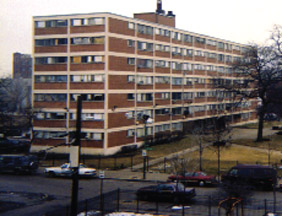


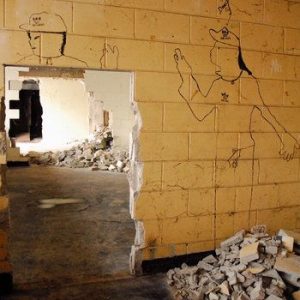
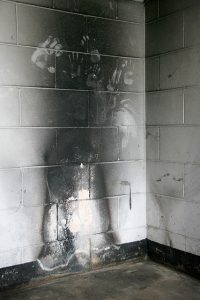

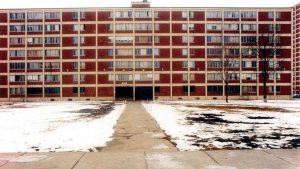
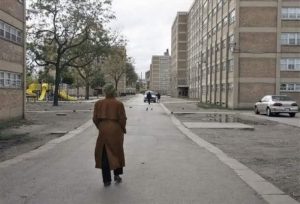
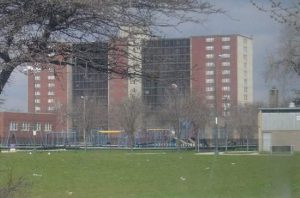

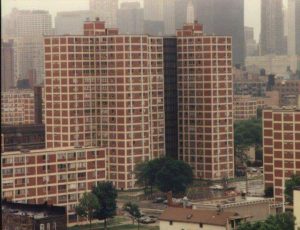
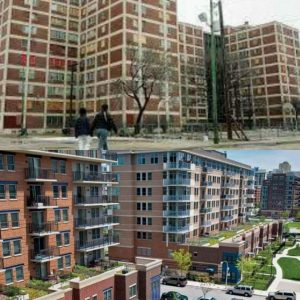

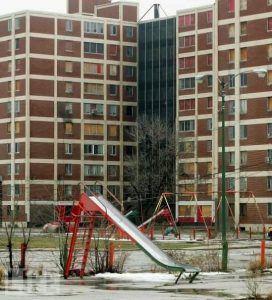


By 2006 the Rockwell Gardens and the Robert Taylor Homes were completely torn down. By 2007 the Grace Abbotts and Stateway Gardens had completed demolition.
In the year 2009 the Harold Ickes and Leclaire Courts became the last projects to begin demolition. In 2010 the Harold Ickes and Henry Horner Homes had completed demolition. In the year 2011 the last of the Ida B. Wells were torn down and the last of Leclaire Courts were torn down, while the last of the notorious Cabrini Green high rises were also demolished. In about 2014 the Maplewood Courts were at last torn down as the last of the public housing demolitions.
During the demolition and after the demolition many wondered what was going to be the plan. The residents of public housing were the ones mainly concerned with where they were going to go after their homes were ripped down. Between the years 1995-2011 residents waited anxiously to find out if their building was next to be torn down, those in the row houses or mid-rise apartments were not even sure if their buildings would be knocked down or just fixed up. Once it was determined a building was to be torn down, the first step was relocating the residents which proved to be an extremely difficult task for CHA. Many people were reluctant to leave their long time homes because of several reasons, one of those reasons was they were deeply saddened to be moved away from long time and close friends they had in the buildings. Earlier in this piece I explained the horrors of these buildings and the nightmare lived; however, everyone that lived there was going through the same thing and they had all grown close to each other in a deep bond that was extremely painful to sever. Many residents suffered depression and incredible grief when the buildings came down. Many residents were filled with fond memories of hanging out with friends and neighbors in the buildings, some even grew up in these buildings, barbecues, long talks, borrowing spices from each other to make a meal, looking out for each other and offering support during hard times, were all memories that could not be forgotten and moving away from each other was devastating. In the article Last Days At Ogden Courtswritten by Cenabeth Cross on January 13, 2007 for the We The People Media, Cross told a story of a woman that resided in the Ogden Courts that had a good friend that resided in those buildings and had lived there a long time, when that friend first heard the news of demolition of the building the woman jumped out of her 5th floor window and plunged to her death as her friend tried to stop her from the suicide, this is a prime example of the deep attachment residents had to these buildings and their neighbors. Even though these buildings were a living hell and almost like being in a prison, these people often did not want to leave, almost as if they developed institutionalization which is a psychological phenomenon usually found in prisoners. Many other residents were glad to escape the hell they were living and felt the process could not move fast enough. For many others the process was bitter sweet because they remembered the good times but knew this was no place for people to live.
The process of relocation was extremely tough not only for CHA but for residents as well because they were used to project living and socialized by that way of life. Many residents were used to living a little on the disorganized and dirty side. Residents were not used to things like taking their garbage outside nor were they accustomed to using a garbage disposal or used to cleaning carpets or keeping them clean. Many lacked skills in keeping their homes tidy and clean because no one ever taught them before, not only that many felt it was pointless in the projects due to continuous onslaughts of vermin that could not be avoided.
CHA staff had training offered for tenants that were being forced to move, teaching them good housekeeping and how to use certain household items they were not accustomed to using. Residents were also trained on how to conduct themselves in job interviews and gave them the skills to find employment and dress appropriately once they were given an interview, this was important because many were about to move into communities that had more job opportunities especially in the suburbs.
In the beginning of demolition in the 1990s most residents were relocated to other housing projects or other low income areas of the city, but in the 2000s decade that was seen as unfair and discriminatory; therefore, opportunities of section 8 housing needed to be offered in better parts of the city or in the suburbs in order for project dwellers to have a fair chance at rehabilitation.
Each resident that was forced to leave their project apartment was given a section 8 voucher along with their notice of eviction. The section 8 voucher gave them the ability to have their rent charged back to them as an affordable amount based upon their income. When finding a landlord that accepted the section 8 voucher the government would pay the majority of the rent that private landlords were charging while tenants would pay the other portion not covered by the government to the landlord.


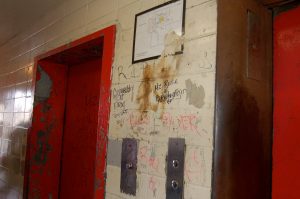
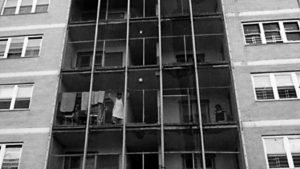
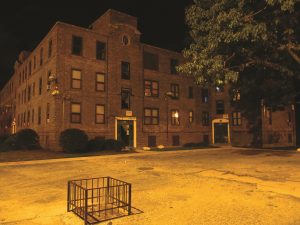
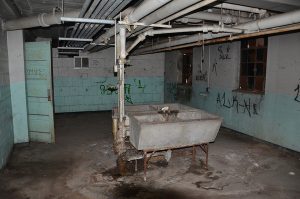
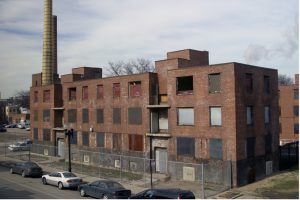
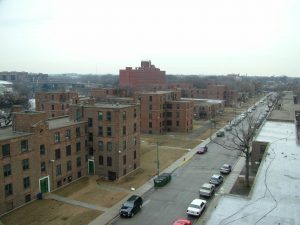

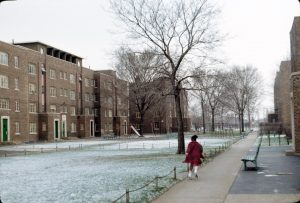
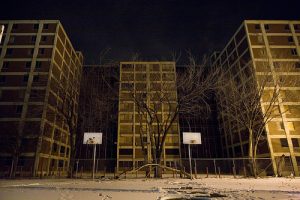
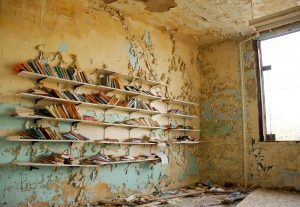

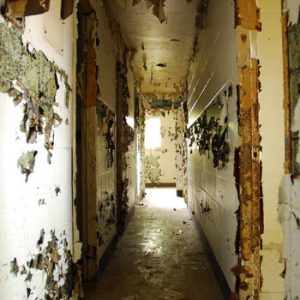
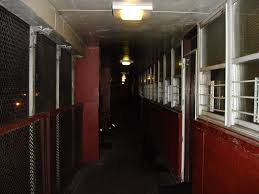

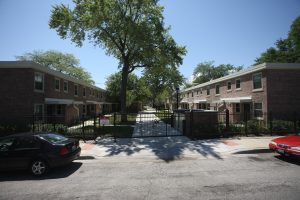

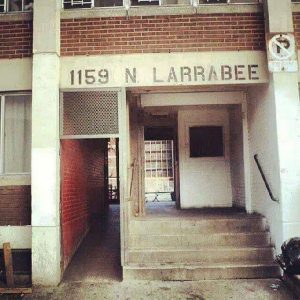

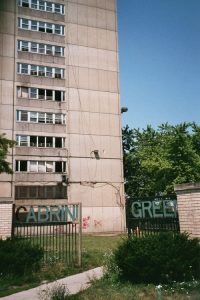
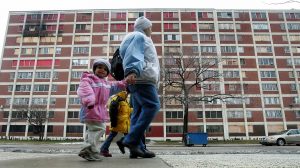
The Chicago Housing Authority worked with several property owners in the private sector of the housing market to set up section 8 friendly buildings and houses. The landlords or property companies would lay out the rules that the section 8 family must abide by that did not allow criminal records or certain criminal offenses and laid out certain rules for cleanliness. CHA counselors would then work with the families to try to get them to pass the test of the landlord. During the final days at the public housing projects, the tenant was expected to live as if they were living in their new apartment by keeping it clean and keeping other people not on the CHA lease out of the apartment. The inspector would come and oversee how they lived and decide if they were fit to be accepted. Many failed the tests especially since vermin often entered even the cleanest apartments, also many guests would come in uninvited which would sometimes ruin the tenants’ chances of getting the apartment they selected.
Project tenants had the power to choose from a list of apartments where they wanted to live but they were subject to being rejected if they were declared not to be a good fit, then they would have to select all over again and pass more tests until they got it right. Some project tenants were easier to work with than others for the CHA as some often did not have the desire to conform to the tidier ways of the new landlords. For some, threats from gangs to allow the quartering of gang members and their stashes became a real problem while the tenant was trying to be selected. A gang member with a gun could easily help himself to a tenants’ property by force at any time and if the tenant told the police or the CHA staff the gang member would inflict violence; therefore, sometimes the process was highly stressful for even the cleanest and most law abiding residents in the projects because they would have to take ownership for that gang member saying that was a cousin or friend or risk getting killed.
Many residents had anxieties about utilities, once the notices were handed out to vacate the projects and they were told they were supposed to move into privately owned apartment complexes, they were also notified that they would become responsible to setup and pay such utilities as gas, water and electricity this was a shock to residents that were used to the buildings controlling the heat and air conditioning. Now they were responsible for calling these various companies and starting services for the first time in their lives once they were accepted into an apartment, condo, townhouse or a house. Project dwellers did not even know how to operate a thermostat or how to manage paying the bills. Sometimes it was not all about coming up with the money to pay those utilities it was all about how to pay them. Project residents were used to only paying one bill and that was to CHA that came around and collected the rent every month, CHA came to them to get the money but now project residents would have to go to these various utility companies to pay, getting money orders, personal checks or even opening online accounts to pay online with utility companies, it was highly stressful if not distressful to people not used to paying anything like this and remembering all these dates.
Once project dwellers got the new apartment they became fearful of overuse of utilities because now using too much water or running the oven too long meant a higher bill, and living on small incomes meant large bills were really scary. CHA had to work tirelessly with former project tenants to get them adjusted to this new type of living, many did not want to live this way and wanted public housing back. For many of the public housing complexes that were torn down, CHA made an immediate promise once the evictions were handed out that new public housing buildings were to built where the projects once stood, this would place residents in newer buildings that were modern and better maintained. Some new projects went successfully like Oakwood Shores where the Ida B. Wells/Darrow/Madden projects once stood, but for most sites like Cabrini Green, Robert Taylor Homes and Leclaire Courts as examples, those replacement projects never happened leaving some former project dwellers homeless living with relatives or friends or even worse in the streets.
Project dwellers had a choice when the evictions were administered to either stay within the public housing system or to take up private section 8 apartments, those that chose to stay in public housing were left with nowhere to go if their complex was not rebuilt, this has been a subject of protest by many former public housing dwellers left out in the cold, once again promises were made but not lived up to.
Most project dwellers never wanted their buildings to be torn down in the first place they would have rather just seen them cleaned up and fixed and ridden of gang activity, but for most of the projects that task was impossible; therefore, demolition was needed but new buildings were promised to take in those former residents but when that did not happen it was another slap in the face. Many excuses have been handed out pointing to delays or a lack of budgeting but to many former residents of public housing it is all a part of “The Plan.”

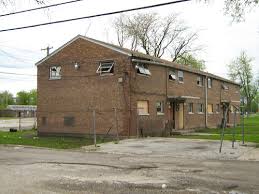
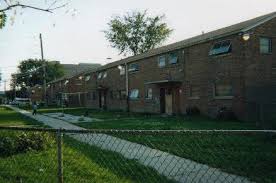


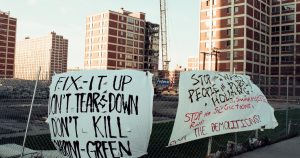
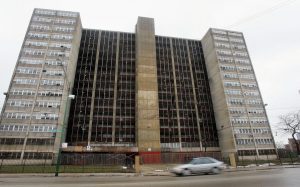

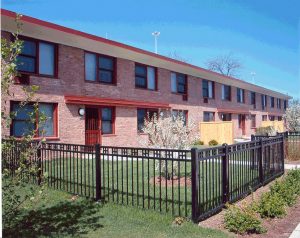
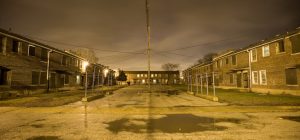
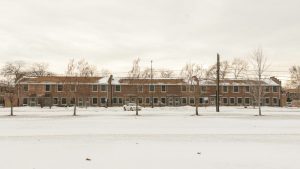


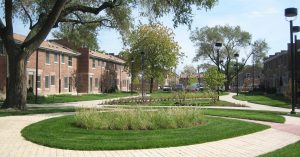
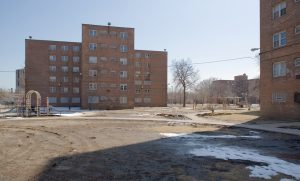
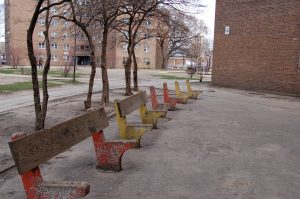

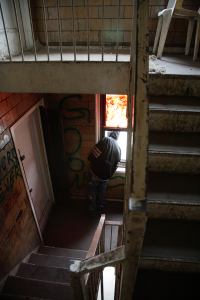
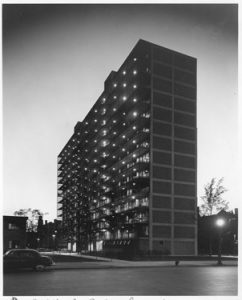
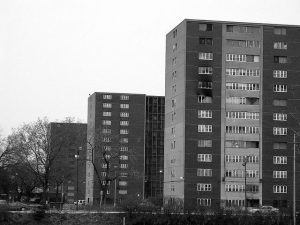
The Plan has been a belief passed down through the generations that the projects were put there to deliberately bring down the value of the land after crime and deterioration ruined the reputation of those grounds, then once the empty property was cheap, corporations and big shot business men could buy and develop there at a rock bottom rate. There have been heavy suspicions over the years that The Plan was indeed a real thing.
During the mass demolition of the projects in the later 1990s and the 2000s decade many residents were temporarily placed in other buildings within their project complex or in other projects in other parts of the city. In the earliest stages of demolition in the mid-1990s through the early 2000s most of the relocation was indeed to other buildings and other Chicago neighborhoods. The initial relocation neighborhoods were usually is rough neighborhoods with high crime and heavy gang activity. Several residents had teenage children or even adult children and other relatives on the lease that were known affiliates of various street gangs. In the projects gangs were known to stake claims on an entire building or on multiple buildings within a complex, once the family had to move to another building or another neighborhood the gang member(s) in the household would often end up being placed in a neighborhood that was unfriendly to their gang affiliation and violence would quickly ensue. A good example happened in the late 1990s when the three buildings at the southern part of the Robert Taylor Homes at 53rd and State Street (The Hole) were slated for demolition, these buildings were all under the control of the Mickey Cobras street gang that was a rival gang to the Gangster Disciples and Black Disciples street gangs that controlled the rest of the buildings in the Robert Taylor Homes, Mickey Cobras were now relocated to the GD and BD controlled towers which caused GDs and BDs to inflict several acts of violence on their new MC neighbors. The transient Mickey Cobras that hung out in the buildings at The Hole were not able to hang out in the GD and BD controlled towers to protect their fellow MCs, so the MCs found themselves seriously outnumbered in the Robert Taylors after the demolition, making gang violence a much worse problem. Before demolition of The Hole towers the MCs were already trying to get ahead by battling the GDs for some more northern control of the towers in order for resident MCs to have safe passage into their new homes which caused several more shootings and violence around these buildings in Washington Park in the late 1990s. This is just one example of placement that went wrong as this was the case in projects all over the city during demolition years, mixing the gangs was something that needed to be avoided and the CHA tried to match up gang affiliations with proper placement the best they could but they sometimes did not know if residents were gang members, only the police knew in some cases and wrongful placements still happened.
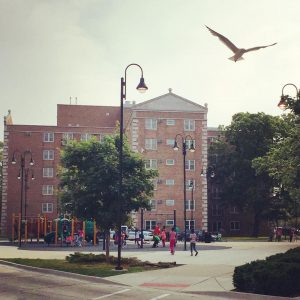
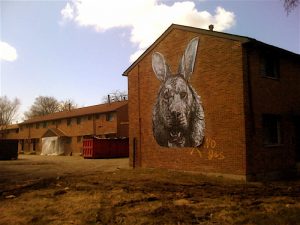
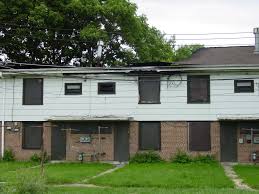
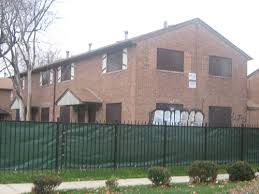
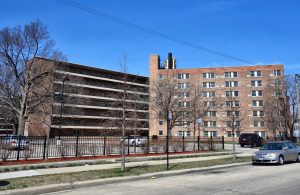
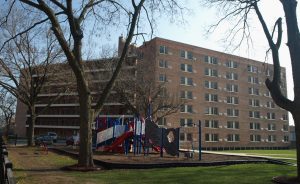

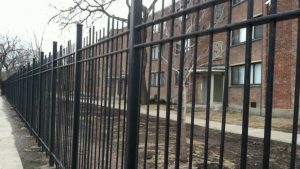



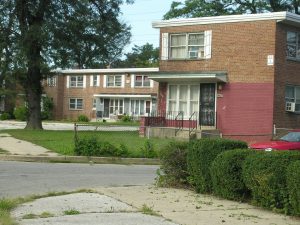

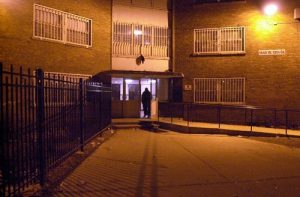

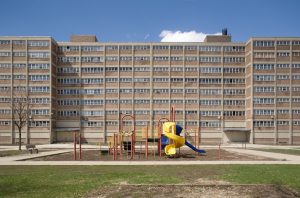

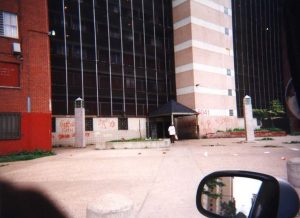
Pressure came down from the entire city government for CHA to get it right because some of the placement outside of the projects was the real problem as gang members from the projects were placed in neighborhoods that did not identify with that particular gang and escalated violence would ensue in that area. There was also conflict in the suburbs as gang members were placed in suburbs that had gangs of rival affiliations, this caused many suburban residents and police to become furious about this placement and even caused many suburbs to protest any section 8 housing.
Conclusion
The high rise public housing projects and the majority of the mid-rise and low rise projects were a major mistake by city planning, or was it a mistake? Some believe the buildup of most of these projects was planned to isolate and put down the black race, leaving them in low income and destitute communities. There has been evidence over the years that this was actually a plan although not officially spelled out. The construction of the high rises has come under heavy scandal over the years because of a combination of factors that include being built in impoverished and destitute areas, being built with poor construction, and CHA funding being siphoned that was meant for repairs. Chicago had a past of treating the black race very poorly and keeping blacks as second rate citizens, it is common knowledge that this was happening in the southern United States but was not as widely known how bad it was in northern cities. Many white citizens of Chicago did not want blacks in their neighborhoods in the 19th century and very early 20th century simply because they did not want them around.
In the mid-20th century whites did not want blacks in their neighborhood because they feared disinvestment that first happened in neighborhoods like the South Loop, Douglas, Grand Boulevard and Washington Park that were dis-invested because of white hatred in the late 19th century and early 20th centuries and by the mid-20th century businesses and lending institutions did not want to work with new black neighborhoods because of the first dis investments in the past which led to racial profiling of certain neighborhoods that were known to be majority black, they based this practice upon what happened in Bronzeville.
In the later 20th century and into the 21st century whites did not want blacks in their neighborhood because of the gangs and crime they brought with them from the rougher areas, but the hatred against blacks of the 19th century and early 20th century that caused disinvestment in black communities, led to the poverty, crime and gangs developing in the black community in the mid-20th century that led to the violent super gangs of the later 20th century in the black community, so as you can see it was like a domino effect that started from old hatreds. The old hatreds bankrupted the black race and put them into low income public housing projects to push them away from the rest of society. The problem is city planners and big income wealthy business men made the decision to build the high rises and isolate the low income black Chicagoans away from everyone else but no one expected the extreme violence and conditions that appeared later on as a result.
As a result of heavy drug profits made by gangs in the high rises they were able to expand their empires across the nation and even into better off suburbs. Even rich white kids were joining gangs like Gangster Disciples and Vice Lords in higher class suburbs because of the power these street gangs developed from raking in millions in drug profits. It is ironic that the city and big businessmen did their best to contain black poverty in these high rises but that caused the gangs to grow tremendously and later spread their wings to the areas in and around Chicago that the city and big business were originally trying to shelter.
I by no means am a liberal and I am not at all a left winger, so please do not look at this as liberal propaganda, but I have to take a liberal stance on the public housing issue of Chicago because this was a grave injustice and it was mainly done to a certain color of people. White, Asian, Middle Eastern and for the most part Latinos were never really placed in any high rise projects except maybe less than 1% between all those races, the high rise dwellers were always black. The rougher mid-rises and low rises were all occupied by over 99% blacks because all these projects were built for blacks and it turned out these projects received the littlest attention to renovations, repairs and law enforcement/security.
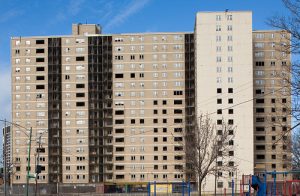
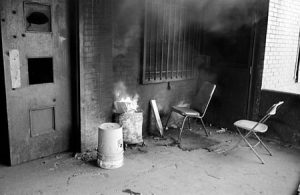
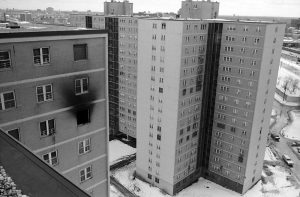
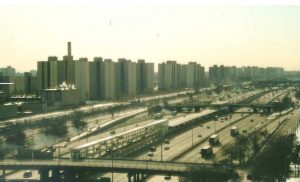
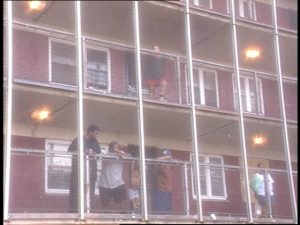
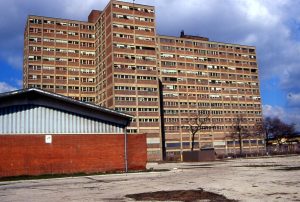
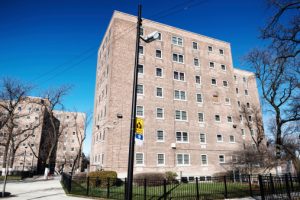

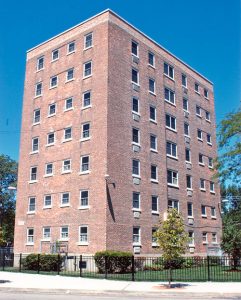
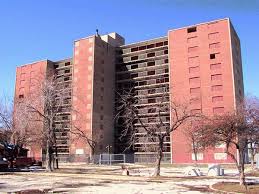
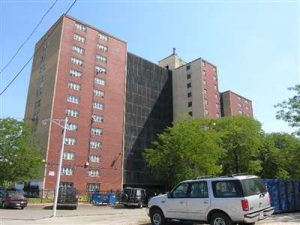


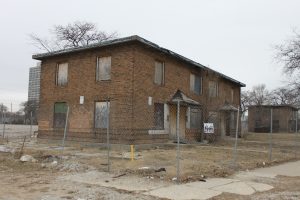
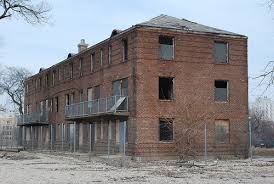

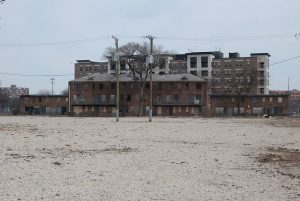

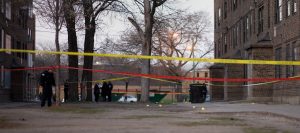
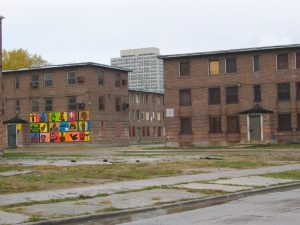
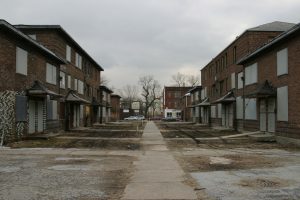

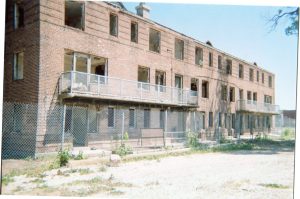
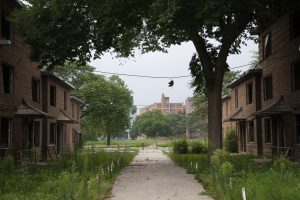
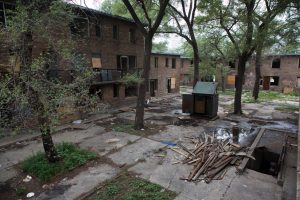
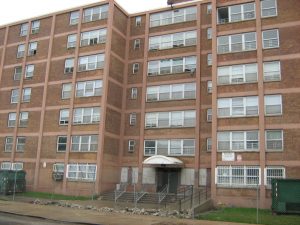
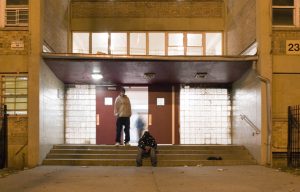
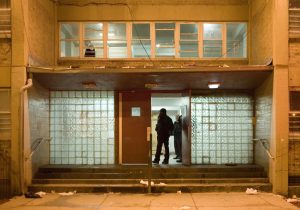
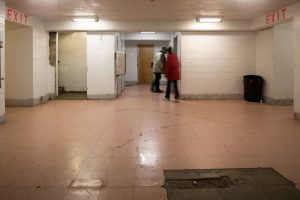
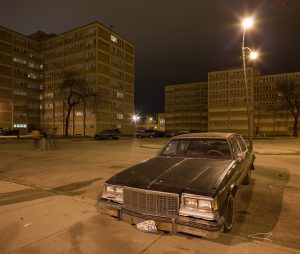
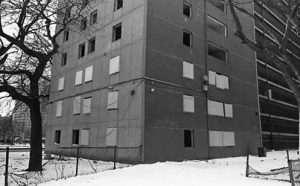



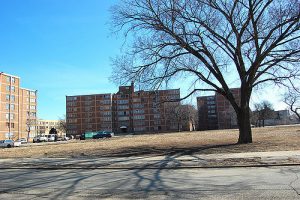
The Bridgeport Homes and Lathrop projects are the only projects that still house impoverished whites. Latinos only dwell in the Bridgeport Homes, Lathrop Homes and Trumbull Park Homes, while blacks still make up a large percentage of even these projects. These projects were protected more by security and received more regular maintenance especially since Lathrop Homes and Bridgeport Homes were in mostly white neighborhoods. Residents in these projects were more inclined to work full time jobs and have better quality lives. Before you try to say it is because whites and Latinos live in them, let us look at the Leclaire Courts before they were torn down, the majority of residents in these projects worked full time jobs as city workers or even nurses and the projects were over 95% black so it has nothing to do with race it has to do with location, and most of the public housing was strategically placed in depressed areas of the city where opportunities were void.
I laid out the many reasons how opportunities were barely existent in these communities at the time when the high rises stood, many people have been hearing this for years but write it off as an excuse, I was guilty of having the same attitude for years until I did the research and found out the details. Residents of public housing that have been waiting years for their new homes to be built are entitled to having those built for them and it should be their right especially after the horrors they endured living within a war stricken community that the city neglected. Imagine if gangs suddenly burst in a high income building in a higher income neighborhood for the purpose of selling drugs through the hallways and preventing police and security from stopping it through violence, imagine if they set curfews for residents and shot them if they disobeyed, imagine if they allowed junkies to shoot up and smoke crack in the lobbies and hallways while they threw up, shit and pissed all over the walls, do you think such an operation would last? Do you think it would carry on for over 40 years? No it would not, police and the military would be all over it and the news would be buzzing with almost 24 hour coverage. Because the projects and the neighborhoods around them were full of impoverished blacks the areas suddenly did not have the law enforcement to remove the problem or the resources, even though Mayor Jane Byrne showed the nation that by simply adding police presence drastically deterred the problems in Cabrini Green back in 1981, yet after she left the projects were still left to rot and the drug empire went on to operate for over 40 years. Budgeting by the city for law enforcement protection is clearly based upon if the area is an area of demand, if there is a lot of businesses, if there is tourism, if there is interest for big business development, if none of those factors exist the city will cut police presence in the area and leave it to rot. If there ever was any funding for repairs and help to these distressed areas some of that funding would magically disappear. Protection for the projects and the areas around those buildings was all also based upon the income of the people living in those areas, since the people did not have money to pay much into taxes the government never made it a priority to provide constant protection to the people living there.

